
- •TABLE OF CONTENTS
- •CHAPTER 1 Structure of Materials
- •CHAPTER 2 Composition of Materials
- •CHAPTER 3 Phase Diagram Sources
- •Compressive Strength
- •Yield Strength
- •Shear Strength
- •Hardness
- •Abrasion Resistance
- •Fracture Toughness
- •Tensile Modulus
- •Young’s Modulus
- •Elastic Modulus
- •Compression Modulus
- •Bulk Modulus
- •Torsion Modulus
- •Modulus of Rupture
- •Elongation
- •Area Reduction
- •Viscosity
- •Dissipation Factor
- •Dielectric Strength
- •Tangent Loss
- •Density
- •Heat of Fusion
- •Thermal Conductivity
- •Thermal Expansion
- •Compressive Strength
- •Yield Strength
- •Flexural Strength
- •Friction
- •Abrasion Resistance
- •Poisson’s Ratio
- •Elongation
- •Area Reduction
- •Dissipation Factor
- •Tangent Loss
- •Permittivity
- •Arc Resistance
- •Flammability

Table 284. VISCOSITY OF GLASSES
(SHEET 1 OF 15)
|
|
|
Temperature |
Glass |
Composition |
Viscosity |
˚C |
|
|
|
|
|
|
|
|
SiO2 glass |
|
12.6-14.4 logP |
1100 |
|
|
11.4-12.8 logP |
1200 |
|
|
10.4-11.83 logP |
1300 |
|
|
9.43-10.65 logP |
1400 |
|
|
8.54-9.52 logP |
1500 |
|
|
7.8-8.53 logP |
1600 |
|
|
7.1-7.65 logP |
1700 |
|
|
6.43-6.9 logP |
1800 |
|
|
5.88-6.2 logP |
1900 |
|
|
5.2-5.4 logP |
2000 |
SiO2-Na2O glass |
(21.7 % mol Na2O) |
4.28 logP |
900 |
|
(21.7 % mol Na2O) |
3.66 logP |
1000 |
|
(21.7 % mol Na2O) |
3.17 logP |
1100 |
|
(21.7 % mol Na2O) |
2.76 logP |
1200 |
|
(21.7 % mol Na2O) |
2.40 logP |
1300 |
|
(21.7 % mol Na2O) |
2.08 logP |
1400 |
|
(23.8 % mol Na2O) |
3.88 logP |
900 |
|
(23.8 % mol Na2O) |
3.28 logP |
1000 |
|
(23.8 % mol Na2O) |
2.82 logP |
1100 |
|
(23.8 % mol Na2O) |
2.44 logP |
1200 |
|
(23.8 % mol Na2O) |
2.10 logP |
1300 |
|
(23.8 % mol Na2O) |
1.84 logP |
1400 |
|
(27.7 % mol Na2O) |
4.33 logP |
800 |
|
(27.7 % mol Na2O) |
3.71 logP |
900 |
|
|
|
|
Source: data compiled by J. S. Park from O. V. Mazurin, M. V. Streltsina and T. P. ShvaikoShvaikovskaya, Handbook of Glass Data, Part A and Part B, Elsevier, New York, 1983
©2001 CRC Press LLC

Table 284. VISCOSITY OF GLASSES
(SHEET 2 OF 15)
|
|
|
Temperature |
Glass |
Composition |
Viscosity |
˚C |
|
|
|
|
|
|
|
|
SiO2-Na2O glass |
(27.7 % mol Na2O) |
3.16 logP |
1000 |
|
(27.7 % mol Na2O) |
2.69 logP |
1100 |
|
(27.7 % mol Na2O) |
2.31 logP |
1200 |
|
(27.7 % mol Na2O) |
1.98 logP |
1300 |
|
(27.7 % mol Na2O) |
1.65 logP |
1400 |
|
(31.7 % mol Na2O) |
4.17 logP |
800 |
|
(31.7 % mol Na2O) |
3.45 logP |
900 |
|
(31.7 % mol Na2O) |
2.92 logP |
1000 |
|
(31.7 % mol Na2O) |
2.48 logP |
1100 |
|
(31.7 % mol Na2O) |
2.12 logP |
1200 |
|
(31.7 % mol Na2O) |
1.83 logP |
1300 |
|
(31.7 % mol Na2O) |
1.59 logP |
1400 |
|
(33.7 % mol Na2O) |
4.06 logP |
800 |
|
(33.7 % mol Na2O) |
3.39 logP |
900 |
|
(33.7 % mol Na2O) |
2.66 logP |
1000 |
|
(33.7 % mol Na2O) |
2.20 logP |
1100 |
|
(33.7 % mol Na2O) |
1.81 logP |
1200 |
|
(33.7 % mol Na2O) |
1.52 logP |
1300 |
|
(36.3 % mol Na2O) |
4.13 logP |
800 |
|
(36.3 % mol Na2O) |
3.40 logP |
900 |
|
(36.3 % mol Na2O) |
2.86 logP |
1000 |
|
(36.3 % mol Na2O) |
2.42 logP |
1100 |
|
(36.3 % mol Na2O) |
2.06 logP |
1200 |
|
|
|
|
Source: data compiled by J. S. Park from O. V. Mazurin, M. V. Streltsina and T. P. ShvaikoShvaikovskaya, Handbook of Glass Data, Part A and Part B, Elsevier, New York, 1983
©2001 CRC Press LLC

Table 284. VISCOSITY OF GLASSES
(SHEET 3 OF 15)
|
|
|
Temperature |
Glass |
Composition |
Viscosity |
˚C |
|
|
|
|
|
|
|
|
SiO2-Na2O glass |
(36.3 % mol Na2O) |
1.76 logP |
1300 |
|
(36.3 % mol Na2O) |
1.51 logP |
1400 |
|
(38.9 % mol Na2O) |
3.91 logP |
800 |
|
(38.9 % mol Na2O) |
3.20 logP |
900 |
|
(38.9 % mol Na2O) |
2.63 logP |
1000 |
|
(38.9 % mol Na2O) |
2.18 logP |
1100 |
|
(38.9 % mol Na2O) |
1.78 logP |
1200 |
|
(38.9 % mol Na2O) |
1.47 logP |
1300 |
|
(41.9 % mol Na2O) |
3.56 logP |
800 |
|
(41.9 % mol Na2O) |
2.83 logP |
900 |
|
(41.9 % mol Na2O) |
2.29 logP |
1000 |
|
(41.9 % mol Na2O) |
1.85 logP |
1100 |
|
(41.9 % mol Na2O) |
1.50 logP |
1200 |
|
(44.0 % mol Na2O) |
3.65 logP |
800 |
|
(44.0 % mol Na2O) |
2.81 logP |
900 |
|
(44.0 % mol Na2O) |
2.24 logP |
1000 |
|
(44.0 % mol Na2O) |
1.80 logP |
1100 |
|
(44.0 % mol Na2O) |
1.43 logP |
1200 |
SiO2-CaO glass |
(30.5% mol CaO) |
13.6 P |
1700 |
|
(30.5% mol CaO) |
10.4 P |
1750 |
|
(30.5% mol CaO) |
8.5 P |
1800 |
|
(34.5% mol CaO) |
10.0 P |
1650 |
|
(34.5% mol CaO) |
7.8 P |
1700 |
|
|
|
|
Source: data compiled by J. S. Park from O. V. Mazurin, M. V. Streltsina and T. P. ShvaikoShvaikovskaya, Handbook of Glass Data, Part A and Part B, Elsevier, New York, 1983
©2001 CRC Press LLC

Table 284. VISCOSITY OF GLASSES
(SHEET 4 OF 15)
|
|
|
Temperature |
Glass |
Composition |
Viscosity |
˚C |
|
|
|
|
|
|
|
|
SiO2-CaO glass |
(34.5% mol CaO) |
6.05 P |
1750 |
|
(34.5% mol CaO) |
4.5 P |
1800 |
|
(41.6% mol CaO) |
9.35 P |
1500 |
|
(41.6% mol CaO) |
6.48 P |
1550 |
|
(41.6% mol CaO) |
4.68 P |
1600 |
|
(41.6% mol CaO) |
3.57 P |
1650 |
|
(41.6% mol CaO) |
2.75 P |
1700 |
|
(41.6% mol CaO) |
2.16 P |
1750 |
|
(41.6% mol CaO) |
1.8 P |
1800 |
|
(48.7% mol CaO) |
4.35 P |
1500 |
|
(48.7% mol CaO) |
3.17 P |
1550 |
|
(48.7% mol CaO) |
2.41 P |
1600 |
|
(48.7% mol CaO) |
1.90 P |
1650 |
|
(48.7% mol CaO) |
1.50 P |
1700 |
|
(48.7% mol CaO) |
1.20 P |
1750 |
|
(48.7% mol CaO) |
0.99 P |
1800 |
|
(52.7% mol CaO) |
3.03 P |
1500 |
|
(52.7% mol CaO) |
2.20 P |
1550 |
|
(52.7% mol CaO) |
1.66 P |
1600 |
|
(52.7% mol CaO) |
1.28 P |
1650 |
|
(52.7% mol CaO) |
1.01 P |
1700 |
|
(52.7% mol CaO) |
0.83 P |
1750 |
|
(52.7% mol CaO) |
0.72 P |
1800 |
|
(54.7% mol CaO) |
2.57 P |
1500 |
|
(54.7% mol CaO) |
1.39 P |
1550 |
|
(54.7% mol CaO) |
1.40 P |
1600 |
|
(54.7% mol CaO) |
1.10 P |
1650 |
|
(54.7% mol CaO) |
0.90 P |
1700 |
|
|
|
|
Source: data compiled by J. S. Park from O. V. Mazurin, M. V. Streltsina and T. P. ShvaikoShvaikovskaya, Handbook of Glass Data, Part A and Part B, Elsevier, New York, 1983
©2001 CRC Press LLC

Table 284. VISCOSITY OF GLASSES
(SHEET 5 OF 15)
|
|
|
Temperature |
Glass |
Composition |
Viscosity |
˚C |
|
|
|
|
|
|
|
|
SiO2-CaO glass |
(54.7% mol CaO) |
0.75 P |
1750 |
|
(54.7% mol CaO) |
0.66 P |
1800 |
|
(57.7% mol CaO) |
1.13 P |
1600 |
|
(57.7% mol CaO) |
0.90 P |
1650 |
|
(57.7% mol CaO) |
0.74 P |
1700 |
|
(57.7% mol CaO) |
0.62 P |
1750 |
|
(57.7% mol CaO) |
0.54 P |
1800 |
SiO2-PbO glass |
(35% mol PbO) |
7380 P |
840 |
|
(35% mol PbO) |
1920 P |
900 |
|
(35% mol PbO) |
620 P |
960 |
|
(35% mol PbO) |
302 P |
1020 |
|
(35% mol PbO) |
164 P |
1080 |
|
(35% mol PbO) |
100.0 P |
1140 |
|
(35% mol PbO) |
62.0 P |
1200 |
|
(35% mol PbO) |
38.2 P |
1260 |
|
(35% mol PbO) |
25.0 P |
1320 |
|
(35% mol PbO) |
16.2 P |
1380 |
|
(35% mol PbO) |
11.8 P |
1440 |
|
(40% mol PbO) |
2970 P |
780 |
|
(40% mol PbO) |
830 P |
840 |
|
(40% mol PbO) |
329 P |
900 |
|
(40% mol PbO) |
164 P |
960 |
|
(40% mol PbO) |
91.0 P |
1020 |
|
(40% mol PbO) |
51.8 P |
1080 |
|
(40% mol PbO) |
31.8 P |
1140 |
|
(40% mol PbO) |
20.4 P |
1200 |
|
|
|
|
Source: data compiled by J. S. Park from O. V. Mazurin, M. V. Streltsina and T. P. ShvaikoShvaikovskaya, Handbook of Glass Data, Part A and Part B, Elsevier, New York, 1983
©2001 CRC Press LLC

Table 284. VISCOSITY OF GLASSES
(SHEET 6 OF 15)
|
|
|
Temperature |
Glass |
Composition |
Viscosity |
˚C |
|
|
|
|
|
|
|
|
SiO2-PbO glass |
(40% mol PbO) |
13.5 P |
1260 |
|
(40% mol PbO) |
10.2 P |
1320 |
|
(46% mol PbO) |
2260 P |
720 |
|
(46% mol PbO) |
494 P |
780 |
|
(46% mol PbO) |
166 P |
840 |
|
(46% mol PbO) |
85.0 P |
900 |
|
(46% mol PbO) |
47.4 P |
960 |
|
(46% mol PbO) |
29.4 P |
1020 |
|
(46% mol PbO) |
18.6 P |
1080 |
|
(46% mol PbO) |
12.7 P |
1140 |
|
(46% mol PbO) |
8.8 P |
1200 |
|
(46% mol PbO) |
6.3 P |
1260 |
|
(46% mol PbO) |
5.2 P |
1320 |
|
(46% mol PbO) |
4.9 P |
1380 |
|
(50% mol PbO) |
21200 P |
600 |
|
(50% mol PbO) |
1600 P |
660 |
|
(50% mol PbO) |
292 P |
720 |
|
(50% mol PbO) |
105 P |
780 |
|
(50% mol PbO) |
43.8 P |
840 |
|
(50% mol PbO) |
22.5 P |
900 |
|
(50% mol PbO) |
13.9 P |
960 |
|
(50% mol PbO) |
8.8 P |
1020 |
|
(50% mol PbO) |
6.0 P |
1080 |
|
(50% mol PbO) |
4.3 P |
1140 |
|
(50% mol PbO) |
2.9 P |
1200 |
|
(55% mol PbO) |
51.0 P |
720 |
|
(55% mol PbO) |
22.4 P |
780 |
|
(55% mol PbO) |
12.6 P |
840 |
|
|
|
|
Source: data compiled by J. S. Park from O. V. Mazurin, M. V. Streltsina and T. P. ShvaikoShvaikovskaya, Handbook of Glass Data, Part A and Part B, Elsevier, New York, 1983
©2001 CRC Press LLC

Table 284. VISCOSITY OF GLASSES
(SHEET 7 OF 15)
|
|
|
Temperature |
Glass |
Composition |
Viscosity |
˚C |
|
|
|
|
|
|
|
|
SiO2-PbO glass |
(55% mol PbO) |
7.10 P |
900 |
|
(55% mol PbO) |
4.44 P |
960 |
|
(55% mol PbO) |
3.00 P |
1020 |
|
(55% mol PbO) |
2.06 P |
1080 |
|
(55% mol PbO) |
1.40 P |
1140 |
|
(55% mol PbO) |
0.98 P |
1200 |
|
(60% mol PbO) |
37.6 P |
660 |
|
(60% mol PbO) |
12.4 P |
720 |
|
(60% mol PbO) |
5.8 P |
780 |
|
(60% mol PbO) |
3.2 P |
840 |
|
(60% mol PbO) |
2.2 P |
900 |
|
(60% mol PbO) |
1.5 P |
960 |
|
(60% mol PbO) |
1.00 P |
1020 |
|
(60% mol PbO) |
0.7 P |
1080 |
|
(64% mol PbO) |
5.2 P |
720 |
|
(64% mol PbO) |
2.5 P |
780 |
|
(64% mol PbO) |
1.23 P |
840 |
|
(64% mol PbO) |
1.00 P |
900 |
|
(64% mol PbO) |
0.70 P |
960 |
|
(64% mol PbO) |
0.50 P |
1020 |
|
(64% mol PbO) |
0.30 P |
1080 |
|
(66.7% mol PbO) |
1.60 P |
780 |
|
(66.7% mol PbO) |
1.00 P |
840 |
|
(66.7% mol PbO) |
0.70 P |
900 |
|
(66.7% mol PbO) |
0.50 P |
960 |
|
(66.7% mol PbO) |
0.35 P |
1020 |
|
(70% mol PbO) |
1.80 P |
720 |
|
(70% mol PbO) |
1.17 P |
780 |
|
(70% mol PbO) |
0.80 P |
840 |
|
|
|
|
Source: data compiled by J. S. Park from O. V. Mazurin, M. V. Streltsina and T. P. ShvaikoShvaikovskaya, Handbook of Glass Data, Part A and Part B, Elsevier, New York, 1983
©2001 CRC Press LLC

Table 284. VISCOSITY OF GLASSES
(SHEET 8 OF 15)
|
|
|
Temperature |
Glass |
Composition |
Viscosity |
˚C |
|
|
|
|
|
|
|
|
SiO2-PbO glass |
(70% mol PbO) |
0.40 P |
900 |
|
(70% mol PbO) |
0.20 P |
960 |
SiO2-Al2O3 glass |
(37.1% mol Al2O3) |
5.8 P |
1850 |
|
(37.1% mol Al2O3) |
4.1 P |
1900 |
|
(37.1% mol Al2O3) |
3.1 P |
1950 |
|
(37.1% mol Al2O3) |
2.5 P |
2000 |
|
(37.1% mol Al2O3) |
2.2 P |
2050 |
|
(37.1% mol Al2O3) |
1.9 P |
2100 |
|
(46.9% mol Al2O3) |
3.3 P |
1850 |
|
(46.9% mol Al2O3) |
2.4 P |
1900 |
|
(46.9% mol Al2O3) |
1.8 P |
1950 |
|
(46.9% mol Al2O3) |
1.5 P |
2000 |
|
(46.9% mol Al2O3) |
1.3 P |
2050 |
|
(46.9% mol Al2O3) |
1.2 P |
2100 |
|
(70.2% mol Al2O3) |
0.9 P |
1950 |
|
(70.2% mol Al2O3) |
0.8 P |
2000 |
|
(70.2% mol Al2O3) |
0.7 P |
2050 |
|
(70.2% mol Al2O3) |
0.6 P |
2100 |
SiO2-B2O3 glass |
(6.2% mol B2O3) |
33.0 kP |
1763 |
|
(6.2% mol B2O3) |
26.6 kP |
1783 |
|
(6.2% mol B2O3) |
16.9 kP |
1815 |
|
(6.2% mol B2O3) |
13.1 kP |
1840 |
|
(10.1% mol B2O3) |
13.3 kP |
1727 |
|
(10.1% mol B2O3) |
11.2 kP |
1730 |
|
|
|
|
Source: data compiled by J. S. Park from O. V. Mazurin, M. V. Streltsina and T. P. ShvaikoShvaikovskaya, Handbook of Glass Data, Part A and Part B, Elsevier, New York, 1983
©2001 CRC Press LLC

Table 284. VISCOSITY OF GLASSES
(SHEET 9 OF 15)
|
|
|
Temperature |
Glass |
Composition |
Viscosity |
˚C |
|
|
|
|
|
|
|
|
SiO2-B2O3 glass |
(10.1% mol B2O3) |
10.9 kP |
1736 |
|
(10.1% mol B2O3) |
11.4 kP |
1738 |
|
(10.1% mol B2O3) |
11.0 kP |
1740 |
|
(10.1% mol B2O3) |
9.07 kP |
1757 |
|
(10.1% mol B2O3) |
8.57 kP |
1768 |
|
(10.1% mol B2O3) |
7.78 kP |
1775 |
|
(10.1% mol B2O3) |
6.54 kP |
1778 |
|
(10.1% mol B2O3) |
5.83 kP |
1792 |
|
(14.5% mol B2O3) |
3.51 kP |
1691 |
|
(14.5% mol B2O3) |
3.37 kP |
1693 |
|
(14.5% mol B2O3) |
2.63 kP |
1720 |
|
(14.5% mol B2O3) |
2.45 kP |
1725 |
|
(14.5% mol B2O3) |
1.92 kP |
1752 |
|
(14.5% mol B2O3) |
1.85 kP |
1757 |
|
(14.5% mol B2O3) |
1.47 kP |
1778 |
|
(14.5% mol B2O3) |
1.45 kP |
1783 |
|
(14.5% mol B2O3) |
1.17 kP |
1797 |
|
(14.5% mol B2O3) |
1.14 kP |
1800 |
|
(14.5% mol B2O3) |
1.12 kP |
1802 |
|
(14.5% mol B2O3) |
1.00 kP |
1812 |
|
(14.5% mol B2O3) |
0.97 kP |
1816 |
|
(25.2% mol B2O3) |
127.0 kP |
1303 |
|
(25.2% mol B2O3) |
89.8 kP |
1329 |
|
|
|
|
Source: data compiled by J. S. Park from O. V. Mazurin, M. V. Streltsina and T. P. ShvaikoShvaikovskaya, Handbook of Glass Data, Part A and Part B, Elsevier, New York, 1983
©2001 CRC Press LLC

Table 284. VISCOSITY OF GLASSES
(SHEET 10 OF 15)
|
|
|
Temperature |
Glass |
Composition |
Viscosity |
˚C |
|
|
|
|
|
|
|
|
SiO2-B2O3 glass |
(25.2% mol B2O3) |
67.4 kP |
1355 |
|
(25.2% mol B2O3) |
44.5 kP |
1376 |
|
(25.2% mol B2O3) |
32.0 kP |
1418 |
|
(25.2% mol B2O3) |
21.9 kP |
1444 |
|
(42.4% mol B2O3) |
-2.37+9823/T log P |
1100-1460 |
|
(53.1% mol B2O3) |
-1.96+8239/T log P |
1380-1530 |
|
(62.4% mol B2O3) |
-1.99+7687/T log P |
1280-1460 |
|
(71.9% mol B2O3) |
-1.24+5740/T log P |
1130-1410 |
|
(75.4 % mol B2O3) |
119000 P |
530 |
|
(75.4 % mol B2O3) |
15230 P |
630 |
|
(75.4 % mol B2O3) |
3400 P |
800 |
|
(79.7 % mol B2O3) |
49500 P |
530 |
|
(79.7 % mol B2O3) |
9300 P |
630 |
|
(79.7 % mol B2O3) |
1400 P |
800 |
|
(81.9% mol B2O3) |
11.61-14.06 log P |
243-306 |
|
(82.5% mol B2O3) |
0.90+4576/T log P |
1050-1360 |
|
(86.3 % mol B2O3) |
17000 P |
530 |
|
(86.3 % mol B2O3) |
4000 P |
630 |
|
(86.3 % mol B2O3) |
425 P |
800 |
|
(90.0% mol B2O3) |
0.42+3434/T log P |
1030-1360 |
|
|
|
|
Source: data compiled by J. S. Park from O. V. Mazurin, M. V. Streltsina and T. P. ShvaikoShvaikovskaya, Handbook of Glass Data, Part A and Part B, Elsevier, New York, 1983
©2001 CRC Press LLC

Table 284. VISCOSITY OF GLASSES
(SHEET 11 OF 15)
|
|
|
Temperature |
Glass |
Composition |
Viscosity |
˚C |
|
|
|
|
|
|
|
|
SiO2-B2O3 glass |
(90.4 % mol B2O3) |
15300 P |
530 |
|
(90.4 % mol B2O3) |
4400 P |
630 |
|
(90.4 % mol B2O3) |
565 P |
800 |
|
(93.1 % mol B2O3) |
7150 P |
530 |
|
(93.1 % mol B2O3) |
2200 P |
630 |
|
(93.1 % mol B2O3) |
420 P |
800 |
|
(93.91% mol B2O3) |
0.68+3655/T log P |
1070-1350 |
|
(97.7 % mol B2O3) |
6900 P |
530 |
|
(97.7 % mol B2O3) |
2730 P |
630 |
|
(97.7 % mol B2O3) |
410 P |
800 |
B2O3 glass |
|
9.799 log P |
325 |
|
|
8.602 log P |
350 |
|
|
7.602 log P |
375 |
|
|
6.415 log P |
411 |
|
|
5.484 log P |
450 |
|
|
4.611 log P |
500 |
|
|
4.029 log P |
550 |
|
|
3.561 log P |
600 |
|
|
2.959 log P |
700 |
|
|
2.549 log P |
800 |
|
|
2.245 log P |
900 |
|
|
2.000 log P |
1000 |
|
|
1.785 log P |
1100 |
|
|
1.603 log P |
1200 |
|
|
1.462 log P |
1300 |
|
|
1.335 log P |
1400 |
|
|
|
|
Source: data compiled by J. S. Park from O. V. Mazurin, M. V. Streltsina and T. P. ShvaikoShvaikovskaya, Handbook of Glass Data, Part A and Part B, Elsevier, New York, 1983
©2001 CRC Press LLC

Table 284. VISCOSITY OF GLASSES
(SHEET 12 OF 15)
|
|
|
Temperature |
Glass |
Composition |
Viscosity |
˚C |
|
|
|
|
|
|
|
|
B2O3 glass |
|
4.65 P |
1829 |
|
|
3.87 P |
1863 |
B2O3-CaO glass |
(32.0 % mol CaO) |
12.51 log P |
646.5 |
|
(32.0 % mol CaO) |
12.02 log P |
654.8 |
|
(32.0 % mol CaO) |
10.64 log P |
674.8 |
|
(32.0 % mol CaO) |
9.17 log P |
697.2 |
|
(34.0 % mol CaO) |
11.32 log P |
656.1 |
|
(34.0 % mol CaO) |
10.68 log P |
667.1 |
|
(34.0 % mol CaO) |
9.88 log P |
681.3 |
|
(34.0 % mol CaO) |
10.51 log P |
671.3 |
|
(34.0 % mol CaO) |
11.60 log P |
653.6 |
|
(34.0 % mol CaO) |
10.48 log P |
668.9 |
|
(34.0 % mol CaO) |
9.09 log P |
691.5 |
|
(34.0 % mol CaO) |
11.37 log P |
657.2 |
|
(55.0 % mol CaO) |
12.92 log P |
650 |
|
(55.0 % mol CaO) |
9.84 log P |
700 |
|
(55.0 % mol CaO) |
7.32 log P |
750 |
|
(55.0 % mol CaO) |
5.38 log P |
800 |
|
(55.0 % mol CaO) |
2.60 log P |
900 |
|
(55.0 % mol CaO) |
1.96 log P |
950 |
|
(55.0 % mol CaO) |
1.38 log P |
1000 |
|
(55.0 % mol CaO) |
0.96 log P |
1050 |
|
(55.0 % mol CaO) |
0.74 log P |
1100 |
B2O3-Na2O glass |
(5% mol Na2O) |
7.83x1014 P |
285 |
|
(5% mol Na2O) |
5.86x1013 P |
300 |
|
(5% mol Na2O) |
1.99x1013 P |
309 |
|
(9.9% mol Na2O) |
3.371 log P |
630 |
|
(9.9% mol Na2O) |
3.095 log P |
650 |
|
(9.9% mol Na2O) |
2.586 log P |
700 |
|
|
|
|
Source: data compiled by J. S. Park from O. V. Mazurin, M. V. Streltsina and T. P. ShvaikoShvaikovskaya, Handbook of Glass Data, Part A and Part B, Elsevier, New York, 1983
©2001 CRC Press LLC

Table 284. VISCOSITY OF GLASSES
(SHEET 13 OF 15)
|
|
|
Temperature |
Glass |
Composition |
Viscosity |
˚C |
|
|
|
|
|
|
|
|
B2O3-Na2O glass |
(9.9% mol Na2O) |
2.181 log P |
750 |
|
(9.9% mol Na2O) |
1.884 log P |
800 |
|
(9.9% mol Na2O) |
1.647 log P |
850 |
|
(9.9% mol Na2O) |
1.569 log P |
870 |
|
(10% mol Na2O) |
1.28x1015 P |
328 |
|
(10% mol Na2O) |
1.41x1014 P |
340 |
|
(10% mol Na2O) |
2.06x1013 P |
351 |
|
(12.8% mol Na2O) |
3.566 log P |
630 |
|
(12.8% mol Na2O) |
3.257 log P |
650 |
|
(12.8% mol Na2O) |
2.695 log P |
700 |
|
(12.8% mol Na2O) |
2.252 log P |
750 |
|
(12.8% mol Na2O) |
1.923 log P |
800 |
|
(12.8% mol Na2O) |
1.661 log P |
850 |
|
(12.8% mol Na2O) |
1.574 log P |
870 |
|
(15% mol Na2O) |
1.44x1015 P |
381 |
|
(15% mol Na2O) |
1.65x1014 P |
394 |
|
(15% mol Na2O) |
2.75x1013 P |
405 |
|
(15.1% mol Na2O) |
3.825 log P |
630 |
|
(15.1% mol Na2O) |
3.457 log P |
650 |
|
(15.1% mol Na2O) |
2.818 log P |
700 |
|
(15.1% mol Na2O) |
2.319 log P |
750 |
|
(15.1% mol Na2O) |
1.942 log P |
800 |
|
(15.1% mol Na2O) |
1.652 log P |
850 |
|
(15.1% mol Na2O) |
1.560 log P |
870 |
|
|
|
|
Source: data compiled by J. S. Park from O. V. Mazurin, M. V. Streltsina and T. P. ShvaikoShvaikovskaya, Handbook of Glass Data, Part A and Part B, Elsevier, New York, 1983
©2001 CRC Press LLC

Table 284. VISCOSITY OF GLASSES
(SHEET 14 OF 15)
|
|
|
Temperature |
Glass |
Composition |
Viscosity |
˚C |
|
|
|
|
|
|
|
|
B2O3-Na2O glass |
(17.5% mol Na2O) |
4.050 log P |
630 |
|
(17.5% mol Na2O) |
3.623 log P |
650 |
|
(17.5% mol Na2O) |
2.881 log P |
700 |
|
(17.5% mol Na2O) |
2.332 log P |
750 |
|
(17.5% mol Na2O) |
1.931 log P |
800 |
|
(17.5% mol Na2O) |
1.633 log P |
850 |
|
(17.5% mol Na2O) |
1.545 log P |
870 |
|
(19.7% mol Na2O) |
4.110 log P |
630 |
|
(19.7% mol Na2O) |
3.712 log P |
650 |
|
(19.7% mol Na2O) |
2.945 log P |
700 |
|
(19.7% mol Na2O) |
2.324 log P |
750 |
|
(19.7% mol Na2O) |
1.875 log P |
800 |
|
(19.7% mol Na2O) |
1.540 log P |
850 |
|
(19.7% mol Na2O) |
1.435 log P |
870 |
|
(20% mol Na2O) |
5.19x1015 P |
435 |
|
(20% mol Na2O) |
1.31x1014 P |
445 |
|
(20% mol Na2O) |
1.57x1013 P |
457 |
|
(21.9% mol Na2O) |
4.185 log P |
630 |
|
(21.9% mol Na2O) |
3.746 log P |
650 |
|
(21.9% mol Na2O) |
2.951 log P |
700 |
|
(21.9% mol Na2O) |
2.324 log P |
750 |
|
(21.9% mol Na2O) |
1.810 log P |
800 |
|
(21.9% mol Na2O) |
1.506 log P |
850 |
|
(21.9% mol Na2O) |
1.392 log P |
870 |
|
|
|
|
Source: data compiled by J. S. Park from O. V. Mazurin, M. V. Streltsina and T. P. ShvaikoShvaikovskaya, Handbook of Glass Data, Part A and Part B, Elsevier, New York, 1983
©2001 CRC Press LLC

Table 284. VISCOSITY OF GLASSES
(SHEET 15 OF 15)
|
|
|
Temperature |
Glass |
Composition |
Viscosity |
˚C |
|
|
|
|
|
|
|
|
B2O3-Na2O glass |
(24.0% mol Na2O) |
4.050 log P |
630 |
|
(24.0% mol Na2O) |
3.598 log P |
650 |
|
(24.0% mol Na2O) |
2.824 log P |
700 |
|
(24.0% mol Na2O) |
2.228 log P |
750 |
|
(24.0% mol Na2O) |
1.782 log P |
800 |
|
(24.0% mol Na2O) |
1.455 log P |
850 |
|
(24.0% mol Na2O) |
1.344 log P |
870 |
|
(25% mol Na2O) |
6.67x1014 P |
445 |
|
(25% mol Na2O) |
1.29x1014 P |
455 |
|
(25% mol Na2O) |
1.31x1013 P |
466 |
|
(26.4% mol Na2O) |
3.865 log P |
630 |
|
(26.4% mol Na2O) |
3.448 log P |
650 |
|
(26.4% mol Na2O) |
2.679 log P |
700 |
|
(26.4% mol Na2O) |
2.086 log P |
750 |
|
(26.4% mol Na2O) |
1.684 log P |
800 |
|
(26.4% mol Na2O) |
1.395 log P |
850 |
|
(26.4% mol Na2O) |
1.300 log P |
870 |
|
(30% mol Na2O) |
2.12x1015 P |
448 |
|
(30% mol Na2O) |
8.06x1014 P |
457 |
|
(30% mol Na2O) |
1.02x1013 P |
467 |
|
|
|
|
Source: data compiled by J. S. Park from O. V. Mazurin, M. V. Streltsina and T. P. ShvaikoShvaikovskaya, Handbook of Glass Data, Part A and Part B, Elsevier, New York, 1983
©2001 CRC Press LLC

Table 285. INTERNAL FRICTION OF SIO2 GLASS
Glass |
Internal Friction |
Temperature |
Frequency |
|
|
|
|
|
|
|
|
SiO2 glass |
4-80x10-7 |
100˚C |
(1.6 MHz) |
|
2-60x10-7 |
200˚C |
(1.6 MHz) |
|
2.5-30x10-7 |
300˚C |
(1.6 MHz) |
|
3.5-9x10-7 |
400˚C |
(1.6 MHz) |
|
4.5-5x10-7 |
500˚C |
(1.6 MHz) |
|
5.5-9x10-7 |
600˚C |
(1.6 MHz) |
|
8-15x10-7 |
700˚C |
(1.6 MHz) |
|
10.5-50x10-7 |
800˚C |
(1.6 MHz) |
|
13.5-95x10-7 |
900˚C |
(1.6 MHz) |
|
15-150x10-7 |
1000˚C |
(1.6 MHz) |
|
|
|
|
Source: data compiled by J.S. Park from O. V. Mazurin, M. V. Streltsina and T. P. ShvaikoShvaikovskaya, Handbook of Glass Data, Part A and Part B, Elsevier, New York, 1983
©2001 CRC Press LLC

Table 286. SURFACE TENSION OF ELEMENTS AT MELTING
(SHEET 1 OF 6)
|
Purity |
σmp |
|
Element |
(wt. %) |
(dyn/cm) |
Atmosphere |
|
|
|
|
|
|
|
|
Ag |
99.7 |
863±25 |
Ar |
|
99.99 |
(785) |
vac. |
|
99.99 |
860±20 |
Ar |
|
99.99 |
865 |
vac. |
|
99.99 |
(825) |
Ar |
|
99.99 |
866 |
He |
|
99.999 |
(828) |
vac. |
|
99.999 |
873 |
He |
|
spect. pure |
921 |
|
|
spect. pure |
918 |
|
Au |
|
(754) |
vac. |
|
99.999 |
1130 |
He |
|
99.999 |
(731) |
vac. |
B |
99.8 |
1060±50 |
vac. |
Ba |
99.5 |
276 |
|
Bi |
99.9 |
380±10 |
Ar |
|
99.98 |
378 |
vac., Ar, H2 |
|
99.98 |
380±10 |
Ar |
|
99.99 |
376 |
vac. |
|
99.999 |
380±3 |
Ar |
|
99.99995 |
375 |
|
Ca |
p.a. |
360 |
|
Cd |
99.9 |
(550±10) |
Ar |
|
|
(525±30) |
H2 |
|
99.9999 |
590±5 |
— |
|
|
|
|
Values in parentheses are less certain.
Source: data from Lang,G.,in Handbook of Chemistry and Physics, 55th ed., Weast, R.C., Ed., CRC Press, Cleveland, 1974, F-23.
©2001 CRC Press LLC

Table 286. SURFACE TENSION OF ELEMENTS AT MELTING
(SHEET 2 OF 6)
|
Purity |
σmp |
|
Element |
(wt. %) |
(dyn/cm) |
Atmosphere |
|
|
|
|
|
|
|
|
Co |
99.99 |
(1520) |
H2, He |
|
99.9983 |
1880 |
vac. |
Cr |
99.9997 |
1700±50 |
Ar |
Cs |
99.995 |
68.6 |
He |
Cu |
99.9 |
(11802±40) |
Ar |
|
99.9 |
(1127) |
vac. |
|
99.98 |
(1085 ) |
vac. |
|
99.98 |
1270 |
vac. |
|
99.997 |
1352 |
vac. |
|
99.997 |
1355 |
He, H2 |
|
99.997 |
1358 |
Ar |
|
99.99999 |
1300 |
vac. |
Fe |
99.69 |
1760±20 |
He, H2 |
|
99.85 |
(1619) |
vac. |
|
99.93 |
(1510) |
vac. |
|
99.93 |
1860±40 |
He |
|
99.985 |
(1560) |
|
|
99.99 |
(1384) |
vac. |
|
99.99 |
(1650) |
He, H2 |
|
99.99 |
(1700) |
vac. |
|
99.9992 |
1773 |
He, H2 |
|
99.9998 |
1880 |
vac. |
Fr |
99.9998 |
718 |
vac., Al2O3 |
|
|
650 |
vac. |
|
|
632±5 |
N2, He |
Hf |
97.5±2.5 |
1630 |
vac. |
|
|
|
|
Values in parentheses are less certain.
Source: data from Lang,G.,in Handbook of Chemistry and Physics, 55th ed., Weast, R.C., Ed., CRC Press, Cleveland, 1974, F-23.
©2001 CRC Press LLC

Table 286. SURFACE TENSION OF ELEMENTS AT MELTING
(SHEET 3 OF 6)
|
Purity |
σmp |
|
Element |
(wt. %) |
(dyn/cm) |
Atmosphere |
|
|
|
|
|
|
|
|
In |
99.95 |
559 |
H2 |
|
99.995 |
556.0 |
Ar, He |
Ir |
99.9980 |
2250 |
vac. |
K |
99.895 |
101 |
Ar |
|
99.895 |
110.3± 1 |
— |
|
99.895 |
117 |
vac. |
|
99.936 |
(79.2) |
He |
|
99.936 |
95 ±9.5 |
— |
|
99.97±0.64 |
111.35 |
He |
|
99.986 |
116.95 |
Ar |
Mg |
99.5 |
583 |
— |
|
99.91 |
(525±10) |
Ar |
Mn |
99.9985 |
1100 ± 50 |
Ar |
Mo |
99.7 |
2080 |
vac. |
|
99.98 |
2049 |
vac. |
|
99.98 |
2130 |
vac. |
|
99.9996 |
2250 |
vac. |
Na |
99.96 |
210.12 |
Ar |
|
99.982 |
187.4 |
He |
|
99.995 |
191 |
Ar |
|
99.995 |
200.2 ±0.6 |
— |
|
99.995 |
202 |
vac. |
Nb, Cb |
99.99 |
2020 |
vac. |
|
99.9986 |
1900 |
vac. |
Nd |
|
688 |
Ar |
|
|
|
|
Values in parentheses are less certain.
Source: data from Lang,G.,in Handbook of Chemistry and Physics, 55th ed., Weast, R.C., Ed., CRC Press, Cleveland, 1974, F-23.
©2001 CRC Press LLC

Table 286. SURFACE TENSION OF ELEMENTS AT MELTING
(SHEET 4 OF 6)
|
Purity |
σmp |
|
Element |
(wt. %) |
(dyn/cm) |
Atmosphere |
|
|
|
|
|
|
|
|
Ni |
99.7 |
1725 |
vac. |
|
99.999 |
1770±13 |
vac. |
|
99.999 |
1728±10 |
vac. |
|
99.999 |
1822±8 |
vac. |
|
99.999 |
(1670) |
vac. |
|
99.999 |
1760 |
vac. |
|
99.999 |
(1687) |
vac. |
|
99.99975 |
(1977) |
He |
|
– |
1809±20 |
H2, He, |
Os |
99.9998 |
2500 |
vac. |
Pb |
99.9 |
(410±5) |
Ar |
|
99.98 |
450 |
He |
|
99.98 |
451 |
vac. |
|
99.998 |
480 |
H2 |
|
99.999 |
470 |
Ar |
|
99.9995 |
470 |
|
Pd |
— |
1470 |
vac. |
|
99.998 |
1500 |
vac. |
|
99.998 |
1460 |
He |
Pt |
— |
1869 |
CO2 |
|
99.84 |
(1740±20) |
vac. |
|
99.9980 |
1865 |
vac. |
Rb |
— |
(77±5) |
vac. |
|
— |
99.8 |
Ar |
|
99.92 |
91 17 |
Ar |
|
99.997 |
85.7 |
He |
|
|
|
|
Values in parentheses are less certain.
Source: data from Lang,G.,in Handbook of Chemistry and Physics, 55th ed., Weast, R.C., Ed., CRC Press, Cleveland, 1974, F-23.
©2001 CRC Press LLC

Table 286. SURFACE TENSION OF ELEMENTS AT MELTING
(SHEET 5 OF 6)
|
Purity |
σmp |
|
Element |
(wt. %) |
(dyn/cm) |
Atmosphere |
|
|
|
|
|
|
|
|
Re |
99.4 |
2610 |
vac. |
|
99.9999 |
2700 |
vac. |
Ru |
99.9980 |
2250 |
vac. |
Rh |
— |
1940 |
vac. |
|
99.9975 |
2000 |
vac. |
S |
— |
60.9 |
vac. |
Sb |
99.15 |
395±20 |
Ar |
|
99.5 |
383 |
H2, N2 |
|
99.99 |
395±20 |
Ar |
Sn |
99.89 |
543.7 |
— |
|
99.89 |
562 |
vac. |
|
99.9 |
(526±10) |
Ar |
|
99.96 |
552 |
vac. |
|
99.96 |
552 |
Ar |
|
99.99 |
537 |
vac. |
|
99.99 |
530 |
He |
|
99.998 |
566 |
H2 |
|
99.998 |
610 |
vac. |
|
99.999 |
590 |
vac. |
|
99.999 |
555.8±1.9 |
— |
Sr |
99.5 |
303 |
|
Ta |
99.9 |
(1884) |
vac. |
|
99.9983 |
2150 |
vac. |
|
— |
2360 |
vac. |
|
— |
2030 |
vac. |
|
— |
1910 |
vac. |
|
|
|
|
Values in parentheses are less certain.
Source: data from Lang,G.,in Handbook of Chemistry and Physics, 55th ed., Weast, R.C., Ed., CRC Press, Cleveland, 1974, F-23.
©2001 CRC Press LLC

Table 286. SURFACE TENSION OF ELEMENTS AT MELTING
(SHEET 6 OF 6)
|
Purity |
σmp |
|
Element |
(wt. %) |
(dyn/cm) |
Atmosphere |
|
|
|
|
|
|
|
|
Te |
99.4 |
186±2 |
Ar |
|
— |
178 |
— |
Ti |
98.7 |
1510 |
vac. |
|
99.69 |
1402 |
vac. |
|
99.92 |
1390 |
Ar |
|
99.92 |
1460 |
vac. |
|
99.9991 |
1650 |
vac. |
Tl |
— |
464.5 |
Ar |
|
99.999 |
467 |
— |
U |
99.94 |
(1294) |
vac. |
|
— |
1500±75 |
— |
|
— |
1550 |
Ar |
V |
99.9977 |
1950 |
vac. |
|
— |
(1760) |
vac. |
W |
99.8 |
2220 |
vac. |
|
99.9 |
(2000) |
vac. |
|
99.9999 |
2500 |
vac. |
|
— |
2310 |
vac. |
Zn |
99.9 |
750 ±20 |
Ar |
|
99.99 |
757.0±5 |
vac. |
|
99.999 |
761.0 |
vac. |
|
99.9999 |
767.5 |
vac. |
Zr |
— |
1400 |
Ar |
|
99.5 |
1411±70 |
vac. |
|
99.7 |
(1533) |
vac. |
|
99.9998 |
1480 |
vac. |
|
|
|
|
Values in parentheses are less certain.
Source: data from Lang,G.,in Handbook of Chemistry and Physics, 55th ed., Weast, R.C., Ed., CRC Press, Cleveland, 1974, F-23.
©2001 CRC Press LLC

Table 287. SURFACE TENSION OF LIQUID ELEMENTS*
(SHEET 1 OF 15)
|
Purity |
σt |
Temperature |
|
Element |
(wt. %) |
(dyn/cm) |
•C |
Atmosphere |
|
|
|
|
|
|
|
|
|
|
Ag |
99.7 |
σ = (863+25) – |
|
Ar |
0.33 (t–tmp) |
|
|||
|
|
|
|
|
|
99.96 |
893 |
1000 |
H2 |
|
|
862 |
1150 |
|
|
|
849 |
1250 |
|
|
|
908 |
1000 |
vac. |
|
99.72 |
840 |
950 |
vac. |
|
99.99 |
890 |
1000 |
Ar, H2 |
|
|
916 |
1000 |
H2 |
|
|
σ = 865–0.14 |
vac. |
|
|
|
(t–tmp) |
|
|
|
|
|
|
|
|
|
σ = 825–0.05 |
Ar |
|
|
|
(T–993) * |
|
|
|
|
|
|
|
|
|
σ = 866–0.15 |
He |
|
|
|
(t–tmp) |
|
|
|
|
|
|
|
|
99.995 |
907 |
1000 |
H2 |
|
|
894 |
1100 |
|
|
|
876 |
1200 |
|
|
99.999 |
905±10 |
980 |
Ar |
|
|
890±10 |
1108 |
|
|
|
725 |
1600 |
He |
|
|
σ = 873–0.15 |
|
|
|
|
(t–tmp) |
|
|
|
spect. pure |
σ = 1136– |
(valid 1300 to |
|
|
0.174 T |
2200 K) |
|
|
|
|
|
||
|
|
σ = 918–0.149 |
|
|
|
|
(t–tmp) |
|
|
|
|
|
|
|
* T in Kelvin (t in ˚C). Values in parentheses are less certain.
Source: data from Lang,G.,in Handbook of Chemistry and Physics, 55th ed., Weast, R.C., Ed., CRC Press, Cleveland, 1974, F-23.
©2001 CRC Press LLC

Table 287. SURFACE TENSION OF LIQUID ELEMENTS*
(SHEET 2 OF 15)
|
Purity |
σt |
Temperature |
|
Element |
(wt. %) |
(dyn/cm) |
•C |
Atmosphere |
|
|
|
|
|
|
|
|
|
|
Au |
99.999 |
1130±10 |
1108 |
Ar |
|
|
1070 |
1200 |
He |
|
|
1020 |
1300 |
|
Ba |
– |
224 |
720 |
Ar |
|
99.5 |
σ = 351–0.075 |
(valid 1410 to |
|
|
T |
1880 K) * |
|
|
|
|
|
||
Be |
99.98 |
1100 |
1500 |
vac. |
Bi |
99.9 |
362 |
350 |
Ar |
|
|
350 |
700 |
vac. |
|
99.90 |
343 |
800 |
H2 |
|
|
328 |
1000 |
|
|
|
(382) |
450 |
vac. |
|
99.98 |
380 |
450 |
– |
|
|
379 |
300 |
vac. |
|
99.999 |
σ = 380–0.142 |
(valid MP to |
Ar |
|
(t–tmp) |
555•C) |
||
|
|
|
||
|
99.99995 |
σ = 423–0.088 |
(valid 1352 to |
|
|
T |
1555 K) * |
|
|
|
|
|
||
Ca |
– |
337 |
850 |
Ar |
|
p.a. |
σ = 472–0.100 |
(valid 1445 to |
|
|
T |
1655 K) * |
|
|
|
|
|
||
Cd |
99.9 |
604 |
390 |
Ar |
Co |
|
1836 |
1550 |
Ar |
|
99.99 |
1800 |
1520 |
vac., Al2O3 |
|
99.99 |
(1630) |
1520 |
He,Al2O3 |
|
99.99 |
(1640) |
1520 |
He, BeO |
|
|
|
|
|
* T in Kelvin (t in ˚C). Values in parentheses are less certain.
Source: data from Lang,G.,in Handbook of Chemistry and Physics, 55th ed., Weast, R.C., Ed., CRC Press, Cleveland, 1974, F-23.
©2001 CRC Press LLC

Table 287. SURFACE TENSION OF LIQUID ELEMENTS*
(SHEET 3 OF 15)
|
Purity |
σt |
Temperature |
|
Element |
(wt. %) |
(dyn/cm) |
•C |
Atmosphere |
|
|
|
|
|
|
|
|
|
|
Co (Con’t) |
99.99 |
(1560) |
1520 |
He, MgO |
|
99.99 |
1780 |
1520 |
H, Al2O3 |
|
99.99 |
(1620) |
1520 |
He |
|
99.99 |
(1590) |
1520 |
H2 |
|
|
1870 |
1500 |
vac. |
|
|
1815 |
1600 |
vac. |
|
99.99 |
1812 |
1600 |
vac., Al2O3 |
|
99.99 |
1845 |
1550 |
H2, He |
|
99.99 |
1780 |
1550 |
|
Cr |
– |
1590±50 |
1950 |
vac. |
|
99.9997 |
|
|
Ar |
Cs |
|
68.4 |
62 |
Ar |
|
|
67.5 |
62 |
Ar |
|
|
62.9 |
146 |
|
|
99.95 |
69.5 |
39 |
Ar |
|
|
42.8 |
494 |
|
|
|
34.6 |
642 |
|
|
99.995 |
σ = 68.6–0.047 |
(valid 52 to |
He |
|
(t–tmp) |
1100•C) |
||
|
|
|
||
Cu |
|
1269±20 |
1120 |
Ar |
|
|
1285±10 |
1120 |
Ar |
|
99.9 |
1220 |
1100 |
Ar |
|
|
1370 |
1150 |
vac. |
|
|
(1130) |
1183 |
Ar |
|
|
|
|
|
* T in Kelvin (t in ˚C). Values in parentheses are less certain.
Source: data from Lang,G.,in Handbook of Chemistry and Physics, 55th ed., Weast, R.C., Ed., CRC Press, Cleveland, 1974, F-23.
©2001 CRC Press LLC

Table 287. SURFACE TENSION OF LIQUID ELEMENTS*
(SHEET 4 OF 15)
|
Purity |
σt |
Temperature |
|
Element |
(wt. %) |
(dyn/cm) |
•C |
Atmosphere |
|
|
|
|
|
|
|
|
|
|
|
|
σ = 73.74– |
|
|
Cu (Con’t) |
99.99 |
1.791 • 10–2 |
|
|
|
|
(t– tmp) |
|
|
|
|
–9.610 • 10–5 |
|
|
|
|
(t–tmp)2 |
|
|
|
|
+ 6.629 • 10–8 |
(valid 71 to |
Ar |
|
|
(t–tmp)3 |
1011•C) |
|
|
|
|
||
|
99.98 |
1301 |
1100 |
H2 |
|
|
1295 |
1165 |
|
|
|
1287 |
1255 |
|
|
|
1285 |
1120 |
vac. |
|
|
1298 |
1440 |
|
|
99.98 |
1230 |
1600 |
Ar |
|
99.99 |
1290 |
1250 |
He |
|
99.99 |
1300 |
1250 |
H2 |
|
99.997 |
|
|
He, H2 |
|
99.997 |
σ = 1352–0.17 |
|
vac. |
|
(t–tmp) |
|
||
|
|
|
|
|
|
99.997 |
σ = 1358–0.20 |
|
Ar |
|
(t–tmp) |
|
||
|
|
|
|
|
|
|
1285±10 |
1120 |
Ar, He |
|
99.99 |
1320 |
1100 |
Ar, H2 |
|
99.99 |
1265 |
1550 |
H2, He |
|
99.999 |
1341 |
1100 |
N2 |
|
|
1338 |
1150 |
|
|
|
1335 |
1200 |
|
|
|
|
|
|
* T in Kelvin (t in ˚C). Values in parentheses are less certain.
Source: data from Lang,G.,in Handbook of Chemistry and Physics, 55th ed., Weast, R.C., Ed., CRC Press, Cleveland, 1974, F-23.
©2001 CRC Press LLC

Table 287. SURFACE TENSION OF LIQUID ELEMENTS*
(SHEET 5 OF 15)
|
Purity |
σt |
Temperature |
|
|
Element |
(wt. %) |
(dyn/cm) |
•C |
Atmosphere |
|
|
|
|
|
|
|
|
|
|
|
|
|
Cu (Con’t) |
99.99999 |
1268±60 |
1130 |
vac. |
|
Fe |
Armco |
1795 |
1550 |
Ar, N2 |
|
|
|
1754 |
1550 |
vac. |
|
|
99.69 |
(1727) |
1550 |
He, Al2O3 |
|
|
|
(1734) |
1550 |
H2, Al2O3 |
|
|
|
σ = 1760–0.35 |
|
He, H2 |
|
|
|
(t–tmp) |
|
||
|
|
|
|
|
|
|
99.94 |
(1710) |
1560 |
vac., Al2O3 |
|
|
99.97 |
1830±6 |
1550 |
vac., BeO |
|
|
99.985 |
1788 |
1550 |
Ar |
|
|
99.987 |
(1730) |
1550 |
vac. |
|
|
99.99 |
(1610) |
1650 |
He |
|
|
|
(1430) |
1650 |
He |
|
|
|
(1400) |
1650 |
H2 |
|
|
|
1865 |
1550 |
vac., He |
|
|
|
(1430) |
1650 |
He |
|
|
|
(1400) |
1650 |
H |
|
|
|
(1640) |
1650 |
|
|
|
99.9992 |
σ = 773+0.65 t |
(valid 1550 to |
He, H |
2 |
|
|
|
1780•C) |
|
|
Fr |
— |
58.4 |
100 |
|
|
|
|
|
|
Ar |
|
|
— |
718 |
350 |
vac. |
|
|
— |
559 |
1500 |
He, Al2O3 |
|
|
99.9998 |
σ = 718–0.101 |
|
vac., Al2O3 |
|
|
(t–tmp) |
|
|||
|
|
|
|
|
|
|
|
|
|
|
|
* T in Kelvin (t in ˚C). Values in parentheses are less certain.
Source: data from Lang,G.,in Handbook of Chemistry and Physics, 55th ed., Weast, R.C., Ed., CRC Press, Cleveland, 1974, F-23.
©2001 CRC Press LLC

Table 287. SURFACE TENSION OF LIQUID ELEMENTS*
(SHEET 6 OF 15)
|
Purity |
σt |
Temperature |
|
Element |
(wt. %) |
(dyn/cm) |
•C |
Atmosphere |
|
|
|
|
|
|
|
|
|
|
Fr (Con’t) |
99.9998 (Con’t) |
530 |
1200 |
vac. |
|
|
650 |
1000 |
vac. |
Hg |
|
(437) |
20 |
|
|
|
(350.5) |
21 |
|
|
|
476 |
25 |
|
|
|
472 |
25 |
|
|
|
(464) |
25 |
|
|
|
(516) |
25 |
|
|
|
(435) |
25 |
|
|
|
488 |
25 |
|
|
|
(498) |
25 |
|
|
|
476 |
25 |
|
|
|
484±1.5 |
25 |
|
|
|
484.9±1.8 |
25 |
|
|
|
449.7 |
103 |
|
|
|
387.1 |
350 |
|
|
|
(410) |
16 |
air |
|
|
(435.5) |
20 |
air |
|
|
(454.7) |
20 |
Ar |
|
|
(542) |
20 |
H |
|
|
473 |
19 |
H2 |
|
|
476 |
25 |
H2 |
|
|
472 |
20 |
vac |
|
|
(402) |
20 |
vac |
|
|
(432) |
20 |
vac |
|
|
(436) |
20 |
vac. |
|
|
|
|
|
* T in Kelvin (t in ˚C). Values in parentheses are less certain.
Source: data from Lang,G.,in Handbook of Chemistry and Physics, 55th ed., Weast, R.C., Ed., CRC Press, Cleveland, 1974, F-23.
©2001 CRC Press LLC

Table 287. SURFACE TENSION OF LIQUID ELEMENTS*
(SHEET 7 OF 15)
|
Purity |
σt |
Temperature |
|
Element |
(wt. %) |
(dyn/cm) |
•C |
Atmosphere |
|
|
|
|
|
|
|
|
|
|
Hg (Con’t) |
|
480 |
20 |
vac. |
|
|
(420) |
20 |
vac. |
|
|
(410) |
20 |
vac. |
|
|
(455) |
20 |
vac. |
|
|
(465.2) |
20 |
vac. |
|
|
485.5±1.0 |
20 |
vac. |
|
|
(468) |
22 |
vac. |
|
|
473 |
25 |
vac. |
|
|
σ = 489.5–0.20 |
|
|
|
|
t |
|
|
|
99.9 |
|
|
|
|
|
487 |
–10 |
|
|
|
487.3 |
16.5 |
|
|
|
(500±15) |
20 |
|
|
|
484.6±1.3 |
20 |
|
|
|
482.5 ± 3.0 |
20 |
|
|
|
484.9±0.3 |
21.5 |
|
|
|
(465) |
22 |
|
|
|
482.8±9.7 |
23–25 |
|
|
|
483.5±1.0 |
25 |
|
|
|
485.1 |
25 |
|
|
|
485.4±1.2 |
25 |
|
|
|
480 |
25 |
|
|
|
σ=468.7–1.61 |
|
|
|
|
• 10–1t–1.815 |
|
|
|
|
•10–2 t2 |
|
|
|
|
σ = 485.5 – |
|
|
|
|
0.149 t–2.84 • |
|
|
|
|
10–4 t2 |
|
|
|
|
|
|
|
* T in Kelvin (t in ˚C). Values in parentheses are less certain.
Source: data from Lang,G.,in Handbook of Chemistry and Physics, 55th ed., Weast, R.C., Ed., CRC Press, Cleveland, 1974, F-23.
©2001 CRC Press LLC

Table 287. SURFACE TENSION OF LIQUID ELEMENTS*
(SHEET 8 OF 15)
|
Purity |
σt |
Temperature |
|
Element |
(wt. %) |
(dyn/cm) |
•C |
Atmosphere |
|
|
|
|
|
|
|
|
|
|
Hg (Con’t) |
99.99 |
475 |
20 |
|
In |
99.95 |
515 |
600 |
H2 |
|
|
540 |
623 |
|
|
99.995 |
592 |
185 |
vac |
|
|
514 |
600 |
H2 |
|
|
541 |
300 |
|
|
99.999 |
556 |
200 |
Ar |
|
|
535 |
400 |
|
|
|
527.8 |
550 |
|
|
99.9994 |
539 |
350 |
vac. |
|
99.9999 |
σ = 568.0–0.04 |
|
|
|
t–7.08 • 10–5 t2 |
|
|
|
|
|
|
|
|
K |
99.895 |
σ = 117– 0.66 |
|
vac. |
(t–tmp) |
|
|||
|
|
|
|
|
|
|
112 |
87 |
Ar |
|
|
80 |
457 |
|
|
|
64.8 |
677 |
|
|
|
σ = 116.95– |
|
|
|
99.986 |
6.742 •10–2 (t– |
|
|
|
|
tmp) |
|
|
|
|
– 3.836 •10–5 |
|
|
|
|
(t–t )2 |
|
|
|
|
mp |
|
|
|
|
+ 3.707 •10– |
(valid 77 to |
Ar |
|
|
8(t–tmp)3 |
983•C) |
|
|
|
|
||
|
99.936 |
(σ = 76.8–70.3 |
|
|
|
• 10–4 (t–400)) |
|
|
|
|
|
|
|
|
|
|
|
(valid 600 to |
He |
|
|
|
1126•C) |
|
|
|
|
|
|
|
|
|
|
|
* T in Kelvin (t in ˚C). Values in parentheses are less certain.
Source: data from Lang,G.,in Handbook of Chemistry and Physics, 55th ed., Weast, R.C., Ed., CRC Press, Cleveland, 1974, F-23.
©2001 CRC Press LLC
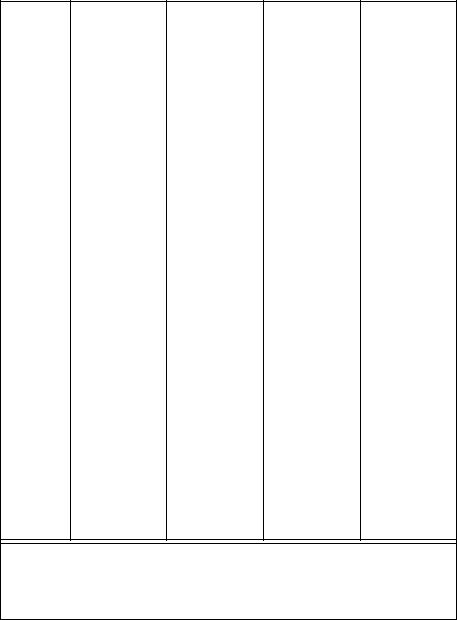
Table 287. SURFACE TENSION OF LIQUID ELEMENTS*
(SHEET 9 OF 15)
|
Purity |
σt |
Temperature |
|
|
Element |
(wt. %) |
(dyn/cm) |
•C |
Atmosphere |
|
|
|
|
|
|
|
|
|
|
|
|
|
K (Con’t) |
99.97±0.64 |
σ = 115.51– |
(valid 70 to |
He |
|
0.0653 t |
713•C) |
||||
|
|
|
|||
Li |
99.95 |
397.5 |
180 |
Ar |
|
|
|
380 |
300 |
|
351.5500
|
99.98 |
386 |
287 |
Ar |
|
|
|
275 |
922 |
|
|
|
|
253 |
1077 |
|
|
Mg |
99.5 |
σ = 721–0.149 |
(valid 1125 to |
|
|
T * |
1326•K) |
|
|||
|
|
|
|||
|
99.8 |
552 |
670 |
N2 |
|
|
|
542 |
700 |
|
|
|
|
528 |
740 |
|
|
|
99.9 |
550±15 |
700 |
Ar |
|
Mn |
99.94 |
1030 |
1550 |
vac. |
|
|
|
1010 |
1550 |
|
|
Na |
99.982 |
σ = 144–0.108 |
(valid 400 to |
He |
|
(t–500) |
1125•C) |
||||
|
|
|
|||
|
99.995 |
198 |
123 |
vac. |
|
|
|
198.5 |
129 |
|
|
|
|
190 |
140 |
|
|
|
|
σ = 202– |
(valid 100 to |
vac |
|
|
|
0.092(t–tmp) |
1000˚C) |
||
|
|
|
* T in Kelvin (t in ˚C). Values in parentheses are less certain.
Source: data from Lang,G.,in Handbook of Chemistry and Physics, 55th ed., Weast, R.C., Ed., CRC Press, Cleveland, 1974, F-23.
©2001 CRC Press LLC
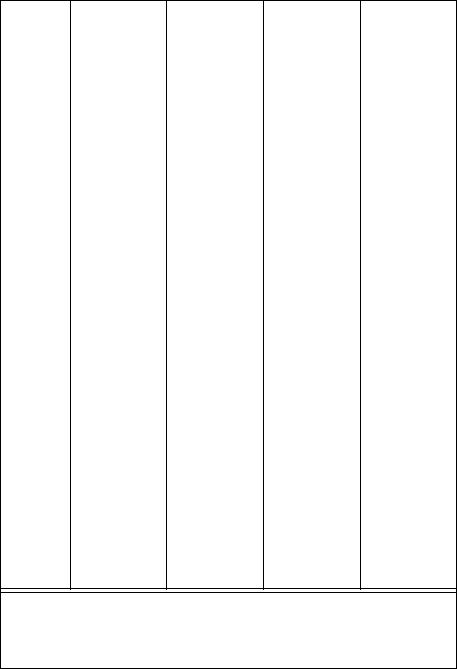
Table 287. SURFACE TENSION OF LIQUID ELEMENTS*
(SHEET 10 OF 15)
|
Purity |
σt |
Temperature |
|
Element |
(wt. %) |
(dyn/cm) |
•C |
Atmosphere |
|
|
|
|
|
|
|
|
|
|
|
|
σ = 210.12– |
|
|
Na (Con’t) |
99.96 |
8.105 • 10–2 (t– |
|
|
|
|
tmp) |
|
|
|
|
– 8.064 •10–5 |
|
|
|
|
(t–tmp)2 |
|
|
|
|
+ 3 .380 • 10 –8 |
(valid 141 to |
Ar |
|
|
(t–tmp)3 |
992•C) |
|
|
|
|
||
|
p.a. |
144 |
617 |
Ar |
|
|
130 |
764 |
|
120.4855
Nd |
|
674 |
1186 |
Ar |
Ni |
99.7 |
(1615) |
1470 |
He |
|
|
(1570) |
1470 |
H2 |
|
|
1735 |
1470 |
vac. |
|
|
1725 |
1475 |
vac. |
|
|
(1934) |
1550 |
Ar |
|
99.99 |
(1490) |
1470 |
He |
|
|
(1500) |
1470 |
He, BeO |
|
|
(1530) |
1470 |
He, MgO |
|
|
(1530) |
1470 |
H2 |
|
|
(1600) |
1520 |
H2,Al2O3 |
|
|
(1650) |
1530 |
H2 |
|
|
1700 |
1470 |
H2, He |
|
|
1720 |
1500 |
vac. |
|
|
1705 |
1640 |
vac. |
* T in Kelvin (t in ˚C). Values in parentheses are less certain.
Source: data from Lang,G.,in Handbook of Chemistry and Physics, 55th ed., Weast, R.C., Ed., CRC Press, Cleveland, 1974, F-23.
©2001 CRC Press LLC

Table 287. SURFACE TENSION OF LIQUID ELEMENTS*
(SHEET 11 OF 15)
|
Purity |
σt |
Temperature |
|
Element |
(wt. %) |
(dyn/cm) |
•C |
Atmosphere |
|
|
|
|
|
|
|
|
|
|
Ni (Con’t) |
99.99 (Con’t) |
1740 |
1520 |
vac., Al2O3 |
|
|
1770 |
1520 |
He,Ar,Al2O3 |
|
|
1780 |
1550 |
vac., Al2O3 |
|
|
1810 |
1560 |
vac., Al2O3 |
|
99.999 |
1745 |
1500 |
He |
|
|
σ = 1770–0.39 |
|
|
|
|
(t–1550) |
|
|
|
99.99975 |
σ = 1665 + |
(valid 1475 to |
He |
|
0.215 t |
1650•C) |
||
|
|
|
||
P(white) |
|
69.7 |
50 |
|
|
|
64.95 |
68.7 |
|
Pb |
99.9 |
388 |
1000 |
H2 |
|
|
445 |
350 |
Ar |
|
99.98 |
448 |
340 |
H, N2 |
|
|
442 |
390 |
|
|
|
439 |
440 |
|
|
|
452 |
360 |
air |
|
|
442 |
340 |
vac. |
|
|
435 |
400 |
|
|
|
440 |
425 |
|
|
|
450 |
350–450 |
|
|
99.998 |
428 |
700 |
vac. |
|
|
474 |
623 |
H2 |
|
|
455 |
362 |
vac. |
|
|
|
|
|
* T in Kelvin (t in ˚C). Values in parentheses are less certain.
Source: data from Lang,G.,in Handbook of Chemistry and Physics, 55th ed., Weast, R.C., Ed., CRC Press, Cleveland, 1974, F-23.
©2001 CRC Press LLC

Table 287. SURFACE TENSION OF LIQUID ELEMENTS*
(SHEET 12 OF 15)
|
Purity |
σt |
|
Temperature |
|
|
Element |
(wt. %) |
(dyn/cm) |
•C |
Atmosphere |
||
|
|
|
|
|
|
|
|
|
|
|
|
|
|
Pb (Con’t) |
99.999 |
456 |
|
390 |
He |
|
|
|
310 |
|
1600 |
|
|
|
|
σ = 470–0.164 |
(valid mp to |
Ar |
||
|
|
(t–tmp) |
535•C) |
|||
|
|
|
||||
|
99.9994 |
438 |
|
450 |
vac |
|
|
99.9995 |
σ = 538–0.114 |
(valid 1440 to |
|
||
|
T * |
|
1970•K) |
|
||
|
|
|
|
|||
Pt |
99.999 |
(1699±20) |
1800 |
Ar |
||
Rb |
|
84 |
|
52 |
Ar |
|
|
|
55 |
|
477 |
|
|
|
|
46.8 |
|
632 |
|
|
|
|
σ = 91.17– |
|
|
||
|
99.92 |
9.189 10–2 (t– |
|
|
||
|
|
tmp) |
|
|
|
|
|
|
+ 7.228 • 10–5 |
|
|
||
|
|
(t–t |
mp |
)2 |
|
|
|
|
|
|
|
|
|
|
|
– 3.830 • 10–8 |
(valid 1104 to |
Ar |
||
|
|
(t–t |
|
)3 |
1006•C) |
|
|
|
mp |
|
|||
|
|
|
|
|
|
|
|
99.997 |
σ = 85.7– |
(valid 53 to |
He |
||
|
0.054 (t–tmp) |
1115•C) |
||||
|
|
|
||||
S |
– |
51.1 |
|
250 |
vac. |
|
Sb |
|
349 |
|
640 |
H2 |
|
|
|
349 |
|
700 |
|
|
|
|
368 |
|
750 |
|
|
|
|
|
|
|
|
|
* T in Kelvin (t in ˚C). Values in parentheses are less certain.
Source: data from Lang,G.,in Handbook of Chemistry and Physics, 55th ed., Weast, R.C., Ed., CRC Press, Cleveland, 1974, F-23.
©2001 CRC Press LLC

Table 287. SURFACE TENSION OF LIQUID ELEMENTS*
(SHEET 13 OF 15)
|
Purity |
σt |
Temperature |
|
Element |
(wt. %) |
(dyn/cm) |
•C |
Atmosphere |
|
|
|
|
|
|
|
|
|
|
Sb (Con’t) |
|
361 |
900 |
|
|
|
342 |
974 |
|
|
|
348 |
1100 |
|
|
|
367.9 |
640 |
vac. |
|
|
364.9 |
762 |
|
|
99.5 |
384 |
675 |
H2, N2 |
|
|
380 |
800 |
|
|
99.995 |
350.2 |
650 |
Ar |
|
|
347.6 |
700 |
|
|
|
345.0 |
800 |
|
|
99.999 |
359 |
800 |
N2 |
|
|
35l |
1000 |
|
|
|
345 |
1100 |
|
|
|
320 |
l600 |
He |
Se |
– |
88.0±5 |
230–250 |
Ar |
Si |
|
725 |
l450 |
He |
|
|
720 |
1550 |
vac. |
|
99.99 |
750 |
1550 |
vac. |
|
99.9999 |
825 |
1500 |
Ar |
Sn |
99.9 |
600 |
290 |
vac. |
|
99.93 |
549 |
250 |
vac. |
|
|
539 |
400 |
|
|
|
526 |
600 |
|
|
99.96 |
470 |
1000 |
vac. |
|
|
σ =552–0.l67 |
(valid MP to |
Ar |
|
|
(t–tmp) |
500•C) |
|
|
|
|
||
|
|
|
|
|
* T in Kelvin (t in ˚C). Values in parentheses are less certain.
Source: data from Lang,G.,in Handbook of Chemistry and Physics, 55th ed., Weast, R.C., Ed., CRC Press, Cleveland, 1974, F-23.
©2001 CRC Press LLC

Table 287. SURFACE TENSION OF LIQUID ELEMENTS*
(SHEET 14 OF 15)
|
Purity |
σt |
Temperature |
|
Element |
(wt. %) |
(dyn/cm) |
•C |
Atmosphere |
|
|
|
|
|
|
|
|
|
|
Sn (Con’t) |
99.965 |
508 |
740 |
H2 |
489.5950
479.51115
99.89 |
554 |
300 |
vac. |
99.99 |
524 |
500 |
vac. |
|
508 |
600 |
|
|
543 |
489 |
H2 |
|
528 |
572 |
|
|
503 |
692 |
|
|
536 |
250 |
|
|
530 |
450 |
|
|
545 |
250 |
|
|
530 |
600 |
H2, He |
99.998 |
559 |
623 |
H2 |
|
500 |
800 |
vac. |
|
538 |
300 |
– |
|
546 |
290 |
– |
99.999 |
(520) |
290 |
H2 |
|
(524) |
290 |
vac. |
|
σ = 566.84 – |
|
|
|
4.76 • 10–2 t |
|
|
99.9994 |
537 |
350 |
vac. |
99.9999 |
552.7 |
246 |
H2 |
* T in Kelvin (t in ˚C). Values in parentheses are less certain.
Source: data from Lang,G.,in Handbook of Chemistry and Physics, 55th ed., Weast, R.C., Ed., CRC Press, Cleveland, 1974, F-23.
©2001 CRC Press LLC

Table 287. SURFACE TENSION OF LIQUID ELEMENTS*
(SHEET 15 OF 15)
|
Purity |
σt |
Temperature |
|
Element |
(wt. %) |
(dyn/cm) |
•C |
Atmosphere |
|
|
|
|
|
|
|
|
|
|
Sr |
|
288 |
775 |
Ar |
|
|
282 |
830 |
|
|
|
282 |
893 |
|
|
99.5 |
σ = 392–0.085 |
(valid 1152 to |
|
|
T |
1602 K) |
|
|
|
|
|
||
Te |
99.4 |
178±1.5 |
460 |
vac. |
|
– |
(162) |
475 |
vac. |
|
|
σ = 178–0.024 |
|
|
|
|
(t–tmp) |
|
|
Ti |
99.0 |
1576 |
1680 |
vac. |
|
99.99999 |
1588 |
1680 |
vac. |
Tl |
– |
450 |
450 |
vac. |
|
99.999 |
450 |
450 |
vac. |
|
|
( σ = 536 – |
(valid 1270 to |
|
|
|
0.119 T )* |
1695•K) |
|
|
|
|
|
|
* T in Kelvin (t in ˚C). Values in parentheses are less certain.
Source: data from Lang,G.,in Handbook of Chemistry and Physics, 55th ed., Weast, R.C., Ed., CRC Press, Cleveland, 1974, F-23.
*The data are a compilation of several studies and measurements were obtained from the “sessile drop”, “maximum bubble pressure” ,and the “pendant drop” methods. The accuracy varies with both method and the study.
©2001 CRC Press LLC
Shackelford, James F. & Alexander, W. “Electrical Properties of Materials”
Materials Science and Engineering Handbook
Ed. James F. Shackelford & W. Alexander Boca Raton: CRC Press LLC, 2001

CHAPTER 7
Electrical Properties
of Materials
List of Tables |
Conductivity and Resistivity |
|
Electrical Conductivity of Metals |
|
Electrical Resistivity of Metals |
|
Electrical Resistivity of Alloy Cast Irons |
|
Resistivity of Ceramics |
|
Volume Resistivity of Glass |
|
Volume Resistivity of Polymers |
Critical Temperature
Critical Temperature of Superconductive Elements
Dissipation Factor
Dissipation Factor for Polymers
Dielectric Strength
Dielectric Strength of Polymers
Step Dielectric Strength of Polymers
Dielectric Constant of Polymers
Dielectric Breakdown of Polymers
Dielectric Breakdown of Polymers
Tangent Loss
Tangent Loss in Glass
Electrical Permittivity
Electrical Permittivity of Glass
©2001 CRC Press LLC
List of Tables |
Arc Resistance |
(Continued) |
Arc Resistance of Polymers |
|
©2001 CRC Press LLC

Table 288. ELECTRICAL CONDUCTIVITY OF METALS
(SHEET 1 OF 7)
|
|
Electrical Conductivity |
Class |
Metal or Alloy |
(%IACS) |
|
|
|
|
|
|
Aluminum and Aluminum Alloys |
Aluminum (99.996%) |
64.95 |
|
EC(O, H19) |
62 |
|
5052 (O, H38) |
35 |
|
5056 (H38) |
27 |
|
6101 (T6) |
56 |
Copper and Copper Alloys: |
|
|
Wrought Copper |
Pure copper |
103.06 |
|
Electolytic (ETP) |
101 |
|
Oxygen–free copper (OF) |
101 |
|
Free–machining copper 0.5% Te |
95 |
|
Free–machining copper 1.0% Pb |
98 |
Wrought Alloys |
Cartridge brass, 70% |
28 |
|
Yellow brass |
27 |
|
Leaded commercial bronze |
42 |
|
Phosphor bronze,1.25% |
48 |
|
Nickel silver, 55–18 |
5.5 |
|
Low–silicon bronze(B) |
12 |
|
Beryllium copper |
22 to 30 |
Copper and copper Alloys: |
|
|
Casting Alloys |
Chromium copper (1% Cr) |
80 to 90 |
|
88Cu–8Sn–4Zn |
11 |
|
87Cu–10Sn–1Pb–2Zn |
11 |
Electrical Contact Materials: |
|
|
Copper Alloys |
0.04 oxide |
100 |
|
1.25 Sn + P |
48 |
|
5 Sn+P |
18 |
|
8 Sn+P |
13 |
|
15 Zn |
37 |
|
20 Zn |
32 |
|
|
|
Data from ASM Metals Reference Book, Third Edition, Michael Bauccio, Ed., ASM International, Materials Park, OH, p157-158, (1993).
©2001 CRC Press LLC

Table 288. ELECTRICAL CONDUCTIVITY OF METALS
(SHEET 2 OF 7)
|
|
Electrical Conductivity |
Class |
Metal or Alloy |
(%IACS) |
|
|
|
|
|
|
|
35 Zn |
27 |
|
2 Be+Ni or Co |
17 to 21 |
Electrical Contact Materials: |
|
|
Silver and Silver Alloys |
Fine silver |
106 |
|
92.5 Ag–7.5Cu |
85 |
|
90Ag–10Cu |
85 |
|
72Ag–28Cu |
87 |
|
72Ag–26Cu–2Ni |
60 |
|
85Ag–15Cd |
35 |
|
97Ag–3Pt |
50 |
|
97Ag–3Pd |
60 |
|
90Ag–10Pd |
30 |
|
90Ag–10Au |
40 |
|
60Ag–40Pd |
8 |
|
70Ag–30Pd |
12 |
Electrical Contact Materials: |
|
|
Platinum and Platinum Alloys |
Platinum |
16 |
|
95Pt–5Ir |
9 |
|
90Pt–10Ir |
7 |
|
85Pt–15Ir |
6 |
|
80Pt–20Ir |
5.6 |
|
75Pt–25Ir |
5.5 |
|
70Pt–30Ir |
5 |
|
65Pt–35Ir |
5 |
|
95Pt–5Ru |
5.5 |
|
90Pt–10Ru |
4 |
|
89Pt–11Ru |
4 |
|
86Pt–14Ru |
3.5 |
|
96Pt–4W |
5 |
|
|
|
Data from ASM Metals Reference Book, Third Edition, Michael Bauccio, Ed., ASM International, Materials Park, OH, p157-158, (1993).
©2001 CRC Press LLC

Table 288. ELECTRICAL CONDUCTIVITY OF METALS
(SHEET 3 OF 7)
|
|
Electrical Conductivity |
Class |
Metal or Alloy |
(%IACS) |
|
|
|
|
|
|
Electrical Contact Materials: |
|
|
Palladium and Palladium Alloys |
Palladium |
16 |
|
95.5Pd–4.5Ru |
7 |
|
90Pd–10Ru |
6.5 |
|
70Pd–30Ag |
4.3 |
|
60Pd 40Ag |
4.0 |
|
50Pd–50Ag |
5.5 |
|
72Pd–26Ag–2Ni |
4 |
|
60Pd–40Cu |
5 |
|
45Pd–30Ag–20Au–5Pt |
4.5 |
|
35Pd–30Ag–14Cu–l0Pt–l0Au–1Zn |
5 |
Electrical Contact Materials: |
|
|
Gold and Gold Alloys |
Gold |
75 |
|
90Au–10Cu |
16 |
|
75Au–25Ag |
16 |
|
72.5Au–14Cu–8.5Pt–4Ag–1Zn |
10 |
|
69Au–25Ag–6Pt |
11 |
|
41.7Au–32.5Cu–18.8Ni–7Zn |
4.5 |
Electrical Heating Alloys: |
|
|
Ni–Cr and Ni–Cr–Fe Alloys |
|
|
|
78.5Ni–20Cr–1.5Si (80–20) |
1.6 |
|
73.5Ni–20Cr–5Al–1.5Si |
1.2 |
|
68Ni–20Cr–8.5Fe–2Si |
1.5 |
|
60Ni–16Cr–22.5Fe–1.5Si |
1.5 |
|
35Ni–20Cr–43.5Fe–1.5Si |
1.7 |
Electrical Heating Alloys: |
|
|
Fe–Cr–Al Alloys |
72Fe–23Cr–5Al |
1.3 |
|
55Fe–37.5Cr–75Al |
1.2 |
Pure Metals |
Molybdenum |
34 |
|
Platinum |
16 |
|
Tantalum |
13.9 |
|
Tungsten |
30 |
|
|
|
Data from ASM Metals Reference Book, Third Edition, Michael Bauccio, Ed., ASM International, Materials Park, OH, p157-158, (1993).
©2001 CRC Press LLC

Table 288. ELECTRICAL CONDUCTIVITY OF METALS
(SHEET 4 OF 7)
|
|
Electrical Conductivity |
|
Class |
Metal or Alloy |
(%IACS) |
|
|
|
|
|
|
|
|
|
Nonmetallic Heating Element |
Silicon carbide, SiC |
1 to 1.7 |
|
Materials |
|||
|
|
||
|
Molybdenum disilicide, MoSi2 |
4.5 |
|
Instrument and Control Alloys: |
|
|
|
Cu–Ni Alloys |
98Cu–2Ni |
35 |
|
|
94Cu–6Ni |
17 |
|
|
89Cu–11Ni |
11 |
|
|
78Cu–22Ni |
5.7 |
|
|
55Cu–45Ni (constantan) |
3.5 |
|
Instrument and Control Alloys: |
|
|
|
Cu–Mn–Ni Alloys |
87Cu–13Mn(manganin) |
3.5 |
|
|
83Cu–13Mn 4Ni(manganin) |
3.5 |
|
|
85Cu–10Mn–4Ni (shunt manganin) |
45 |
|
|
70Cu–20Ni–10Mn |
3.6 |
|
|
67Cu–5Ni–27Mn |
1.8 |
|
Instrument and Control Alloys: |
|
|
|
Ni–Base Alloys |
99.8 Ni |
23 |
|
|
71Ni–29Fe |
9 |
|
|
80Ni–20Cr |
1.5 |
|
|
75Ni–20Cr–3Al+Cu or Fe |
1.3 |
|
|
76Ni–17Cr–4Si–3Mn |
1.3 |
|
|
60Ni–16Cr–24Fe |
1.5 |
|
|
35Ni–20Cr–45Fe |
1.7 |
|
Instrument and Control Alloys: |
|
|
|
Fe–Cr–Al alloy |
72Fe–23Cr–5Al–0.5Co |
1.3 |
|
Instrument and Control Alloys: |
|
|
|
Pure Metals |
Iron(99.99%) |
17.75 |
|
|
|
|
Data from ASM Metals Reference Book, Third Edition, Michael Bauccio, Ed., ASM International, Materials Park, OH, p157-158, (1993).
©2001 CRC Press LLC

Table 288. ELECTRICAL CONDUCTIVITY OF METALS
(SHEET 5 OF 7)
|
|
Electrical Conductivity |
Class |
Metal or Alloy |
(%IACS) |
|
|
|
|
|
|
Thermostat Metals |
75Fe–22Ni–3Cr |
3 |
|
72Mn–18Cu–10Ni |
1.5 |
|
67Ni–30Cu–1.4Fe–1Mn |
3.5 |
|
75Fe–22Ni–3Cr |
12 |
|
66.5Fe–22Ni–8.5Cr |
3.3 |
Permanent Magnet Materials: |
|
|
Steels |
Carbon Steel (0.65%) |
9.5 |
|
Carbon Steel (1% C) |
8 |
|
Chromium Steel (3.5% Cr) |
6.1 |
|
Tungsten Steel (6% W) |
6 |
|
Cobalt Steel (17% Co) |
6.3 |
|
Cobalt Steel (36% Co) |
6.5 |
Permanent Magnet Materials: |
|
|
Intermediate Alloys |
Cunico |
7.5 |
|
Cunife |
9.5 |
|
Comol |
3.6 |
Permanent Magnet Materials: |
|
|
Alnico Alloys |
Alnico I |
3.3 |
|
Alnico II |
3.3 |
|
Alnico III |
3.3 |
|
Alnico IV |
3.3 |
|
Alnico V |
3.5 |
|
Alnico VI |
3.5 |
Magnetically Soft Materials: |
|
|
Electrical Steel Sheet |
M–50 |
9.5 |
|
M–43 |
6 to 9 |
|
M–36 |
5.5 to 7.5 |
|
M–27 |
3.5 to 5.5 |
|
M–22 |
3.5 to 5 |
|
M–19 |
3.5 to 5 |
|
M–17 |
3 to 3.5 |
|
M–15 |
3 to 3.5 |
|
|
|
Data from ASM Metals Reference Book, Third Edition, Michael Bauccio, Ed., ASM International, Materials Park, OH, p157-158, (1993).
©2001 CRC Press LLC

Table 288. ELECTRICAL CONDUCTIVITY OF METALS
(SHEET 6 OF 7)
|
|
Electrical Conductivity |
|
Class |
Metal or Alloy |
(%IACS) |
|
|
|
|
|
|
|
|
|
|
M–14 |
3 to 3.5 |
|
|
M–7 |
3 to 3.5 |
|
|
M–6 |
3 to 3.5 |
|
|
M–5 |
3 to 3.5 |
|
Moderately High–Permeability |
Thermenol |
0.5 |
|
Materials |
|||
|
|
||
|
16 Alfenol |
0.7 |
|
|
Sinimax |
2 |
|
|
Monimax |
2.5 |
|
|
Supermalloy |
3 |
|
|
4–79 Moly Pemalloy, Hymu 80 |
3 |
|
|
Mumetal |
3 |
|
|
1040 alloy |
3 |
|
|
High Permalloy 49, A–L 4750, |
3.6 |
|
|
Armco 48 |
||
|
|
||
|
45 Permalloy |
3.6 |
|
High–Permeability Materials |
Supermendur |
4.5 |
|
|
2V Pamendur |
4.5 |
|
|
35% Co, 1% Cr |
9 |
|
|
Ingot iron |
17.5 |
|
|
0.5% Si Steel |
6 |
|
|
1.75% Si Steel |
4.6 |
|
|
3.0% Si Steel |
3.6 |
|
|
Grain–oriented 3.0% Si Steel |
3.5 |
|
|
Grain–oriented 50% Ni iron |
3.6 |
|
|
50% Ni iron |
3.5 |
|
Relay Steels and Alloys After |
|
|
|
Annealing |
|
|
|
Low–carbon Iron and Steel |
Low–carbon iron |
17.5 |
|
|
1010 Steel |
14.5 |
|
|
|
|
Data from ASM Metals Reference Book, Third Edition, Michael Bauccio, Ed., ASM International, Materials Park, OH, p157-158, (1993).
©2001 CRC Press LLC

Table 288. ELECTRICAL CONDUCTIVITY OF METALS
(SHEET 7 OF 7)
|
|
Electrical Conductivity |
|
Class |
Metal or Alloy |
(%IACS) |
|
|
|
|
|
|
|
|
|
Silicon Steels |
1% Si |
7.5 |
|
|
2.5% Si |
4 |
|
|
3% Si |
3.5 |
|
|
3% Si, grain–oriented |
3.5 |
|
|
4% Si |
3 |
|
Stainless Steels |
Type 410 |
3 |
|
|
Type 416 |
3 |
|
|
Type 430 |
3 |
|
|
Type 443 |
3 |
|
|
Type 446 |
3 |
|
Nickel Irons |
50% Ni |
3.5 |
|
|
78% Ni |
11 |
|
|
77% Ni (Cu, Cr) |
3 |
|
|
79% Ni (Mo) |
3 |
|
Stainless and Heat Resisting |
Type 302 |
3 |
|
Alloys |
|||
|
|
||
|
Type 309 |
2.5 |
|
|
Type 316 |
2.5 |
|
|
Type 317 |
2.5 |
|
|
Type 347 |
2.5 |
|
|
Type 403 |
3 |
|
|
Type 405 |
3 |
|
|
Type 501 |
4.5 |
|
|
HH |
2.5 |
|
|
HK |
2 |
|
|
HT |
1.7 |
|
|
|
|
Data from ASM Metals Reference Book, Third Edition, Michael Bauccio, Ed., ASM International, Materials Park, OH, p157-158, (1993).
©2001 CRC Press LLC

Table 289. ELECTRICAL RESISTIVITY OF METALS
(SHEET 1 OF 7)
|
|
Electrical Resistivity |
Class |
Metal or Alloy |
(µΩ • cm) |
|
|
|
|
|
|
Aluminum and Aluminum Alloys |
Aluminum (99.996%) |
2.65 |
|
EC(O, H19) |
2.8 |
|
5052 (O, H38) |
4.93 |
|
5056 (H38) |
6.4 |
|
6101 (T6) |
3.1 |
Copper and Copper Alloys: |
|
|
Wrought Copper |
Pure copper |
1.67 |
|
Electolytic (ETP) |
1.71 |
|
Oxygen–free copper (OF) |
1.71 |
|
Free–machining copper 0.5% Te |
1.82 |
|
Free–machining copper 1.0% Pb |
1.76 |
Wrought Alloys |
Cartridge brass, 70% |
6.2 |
|
Yellow brass |
6.4 |
|
Leaded commercial bronze |
4.1 |
|
Phosphor bronze, 1.25% |
3.6 |
|
Nickel silver, 55–18 |
31 |
|
Low–silicon bronze(B) |
14.3 |
|
Beryllium copper |
5.7 to 7.8 |
Copper and Copper Alloys: |
|
|
Casting Alloys |
Chromium copper (1% Cr) |
2.10 |
|
88Cu–8Sn–4Zn |
15 |
|
87Cu–10Sn–1Pb–2Zn |
15 |
Electrical Contact Materials: |
|
|
Copper Alloys |
0.04 oxide |
1.72 |
|
1.25 Sn + P |
3.6 |
|
5 Sn+P |
11 |
|
8 Sn+P |
13 |
|
15 Zn |
4.7 |
|
20 Zn |
5.4 |
|
|
|
Data from ASM Metals Reference Book, Third Edition, Michael Bauccio, Ed., ASM International, Materials Park, OH, p157-158, (1993).
©2001 CRC Press LLC

Table 289. ELECTRICAL RESISTIVITY OF METALS
(SHEET 2 OF 7)
|
|
Electrical Resistivity |
Class |
Metal or Alloy |
(µΩ • cm) |
|
|
|
|
|
|
|
35 Zn |
6.4 |
|
2 Be+Ni or Co |
9.6 to 11.5 |
Electrical Contact Materials: |
|
|
Silver and Silver Alloys |
Fine silver |
1.59 |
|
92.5 Ag–7.5Cu |
2 |
|
90Ag–10Cu |
2 |
|
72Ag–28Cu |
2 |
|
72Ag–26Cu–2Ni |
2.9 |
|
85Ag–15Cd |
4.93 |
|
97Ag–3Pt |
3.5 |
|
97Ag–3Pd |
2.9 |
|
90Ag–10Pd |
5.3 |
|
90Ag–10Au |
4.2 |
|
60Ag–40Pd |
23 |
|
70Ag–30Pd |
14.3 |
Electrical Contact Materials: |
|
|
Platinum and Platinum Alloys |
Platinum |
10.6 |
|
95Pt–5Ir |
19 |
|
90Pt–10Ir |
25 |
|
85Pt–15Ir |
28.5 |
|
80Pt–20Ir |
31 |
|
75Pt–25Ir |
33 |
|
70Pt–30Ir |
35 |
|
65Pt–35Ir |
36 |
|
95Pt–5Ru |
31.5 |
|
90Pt–10Ru |
43 |
|
89Pt–11Ru |
43 |
|
86Pt–14Ru |
46 |
|
96Pt–4W |
36 |
|
|
|
Data from ASM Metals Reference Book, Third Edition, Michael Bauccio, Ed., ASM International, Materials Park, OH, p157-158, (1993).
©2001 CRC Press LLC

Table 289. ELECTRICAL RESISTIVITY OF METALS
(SHEET 3 OF 7)
|
|
Electrical Resistivity |
Class |
Metal or Alloy |
(µΩ • cm) |
|
|
|
|
|
|
Electrical Contact Materials: |
|
|
Palladium and Palladium Alloys |
Palladium |
10.8 |
|
95.5Pd–4.5Ru |
24.2 |
|
90Pd–10Ru |
27 |
|
70Pd–30Ag |
40 |
|
60Pd–40Ag |
43 |
|
50Pd–50Ag |
31.5 |
|
72Pd–26Ag–2Ni |
43 |
|
60Pd–40Cu |
35 |
|
45Pd–30Ag–20Au–5Pt |
39 |
|
35Pd–30Ag–14Cu–l0Pt–10Au–1Zn |
35 |
Electrical Contact Materials: |
|
|
Gold and Gold Alloys |
Gold |
2.35 |
|
90Au–10Cu |
10.8 |
|
75Au–25Ag |
10.8 |
|
72.5Au–14Cu–8.5Pt–4Ag–1Zn |
17 |
|
69Au–25Ag–6Pt |
15 |
|
41.7Au–32.5Cu–18.8Ni–7Zn |
39 |
Electrical Heating Alloys: |
|
|
Ni–Cr and Ni–Cr–Fe Alloys |
|
|
|
78.5Ni–20Cr–1.5Si (80–20) |
108.05 |
|
73.5Ni–20Cr–5Al–1.5Si |
137.97 |
|
68Ni–20Cr–8.5Fe–2Si |
116.36 |
|
60Ni–16Cr–22.5Fe–1.5Si |
112.20 |
|
35Ni–20Cr–43.5Fe–1.5Si |
101.4 |
Electrical Heating Alloys: |
|
|
Fe–Cr–Al Alloys |
72Fe–23Cr–5Al |
138.8 |
|
55Fe–37.5Cr–7.5Al |
166.23 |
Pure Metals |
Molybdenum |
5.2 |
|
Platinum |
10.64 |
|
Tantalum |
12.45 |
|
Tungsten |
5.65 |
|
|
|
Data from ASM Metals Reference Book, Third Edition, Michael Bauccio, Ed., ASM International, Materials Park, OH, p157-158, (1993).
©2001 CRC Press LLC

Table 289. ELECTRICAL RESISTIVITY OF METALS
(SHEET 4 OF 7)
|
|
Electrical Resistivity |
|
Class |
Metal or Alloy |
(µΩ • cm) |
|
|
|
|
|
|
|
|
|
Nonmetallic Heating Element |
Silicon carbide, SiC |
100 to 200 |
|
Materials |
|||
|
|
||
|
Molybdenum disilicide, MoSi2 |
37.24 |
|
|
Graphite |
910.1 |
|
Instrument and Control Alloys: |
|
|
|
Cu–Ni Alloys |
98Cu–2Ni |
4.99 |
|
|
94Cu–6Ni |
9.93 |
|
|
89Cu–11Ni |
14.96 |
|
|
78Cu–22Ni |
29.92 |
|
|
55Cu–45Ni (constantan) |
49.87 |
|
Instrument and Control Alloys: |
|
|
|
Cu–Mn–Ni Alloys |
87Cu–13Mn(manganin) |
48.21 |
|
|
83Cu–13Mn–4Ni(manganin) |
48.21 |
|
|
85Cu–10Mn–4Ni (shunt manganin) |
38.23 |
|
|
70Cu–20Ni–10Mn |
48.88 |
|
|
67Cu–5Ni–27Mn |
99.74 |
|
Instrument and Control Alloys: |
|
|
|
Ni–base Alloys |
99.8 Ni |
7.98 |
|
|
71Ni–29Fe |
19.95 |
|
|
80Ni–20Cr |
112.2 |
|
|
75Ni–20Cr–3Al+Cu or Fe |
132.98 |
|
|
76Ni–17Cr–4Si–3Mn |
132.98 |
|
|
60Ni–16Cr–24Fe |
112.2 |
|
|
35Ni–20Cr–45Fe |
101.4 |
|
Instrument and Control Alloys: |
|
|
|
Fe–Cr–Al alloy |
72Fe–23Cr–5Al–0.5Co |
135.48 |
|
Instrument and Control Alloys: |
|
|
|
Pure Metals |
Iron(99.99%) |
9.71 |
|
|
|
|
Data from ASM Metals Reference Book, Third Edition, Michael Bauccio, Ed., ASM International, Materials Park, OH, p157-158, (1993).
©2001 CRC Press LLC

Table 289. ELECTRICAL RESISTIVITY OF METALS
(SHEET 5 OF 7)
|
|
Electrical Resistivity |
Class |
Metal or Alloy |
(µΩ • cm) |
|
|
|
|
|
|
Thermostat Metals |
75Fe–22Ni–3Cr |
78.13 |
|
72Mn–18Cu–10Ni |
112.2 |
|
67Ni–30Cu–1.4Fe–1Mn |
56.52 |
|
75Fe–22Ni–3Cr |
15.79 |
|
66.5Fe–22Ni–8.5Cr |
58.18 |
Permanent Magnet Materials: |
|
|
Steels |
Carbon Steel (0.65%) |
18 |
|
Carbon Steel (1% C) |
20 |
|
Chromium Steel (3.5% Cr) |
29 |
|
Tungsten Steel (6% W) |
30 |
|
Cobalt Steel (17% Co) |
28 |
|
Cobalt Steel (36% Co) |
27 |
Permanent Magnet Materials: |
|
|
Intermediate Alloys |
Cunico |
24 |
|
Cunife |
18 |
|
Comol |
45 |
Permanent Magnet Materials: |
|
|
Alnico Alloys |
Alnico I |
75 |
|
Alnico II |
65 |
|
Alnico III |
60 |
|
Alnico IV |
75 |
|
Alnico V |
47 |
|
Alnico VI |
50 |
Magnetically Soft Materials: |
|
|
Electrical Steel Sheet |
M–50 |
18 |
|
M–43 |
20 to 28 |
|
M–36 |
24 to 33 |
|
M–27 |
32 to 47 |
|
M–22 |
41 to 52 |
|
M–19 |
41 to 56 |
|
M–17 |
45 to 58 |
|
M–15 |
45 to 69 |
|
|
|
Data from ASM Metals Reference Book, Third Edition, Michael Bauccio, Ed., ASM International, Materials Park, OH, p157-158, (1993).
©2001 CRC Press LLC

Table 289. ELECTRICAL RESISTIVITY OF METALS
(SHEET 6 OF 7)
|
|
Electrical Resistivity |
|
Class |
Metal or Alloy |
(µΩ • cm) |
|
|
|
|
|
|
|
|
|
|
M–14 |
58 to 69 |
|
|
M–7 |
45 to 52 |
|
|
M–6 |
45 to 52 |
|
|
M–5 |
45 to 52 |
|
Moderately High–Permeability |
Thermenol |
162 |
|
Materials |
|||
|
|
||
|
16 Alfenol |
153 |
|
|
Sinimax |
90 |
|
|
Monimax |
80 |
|
|
Supermalloy |
65 |
|
|
4–79 Moly Pemalloy, Hymu 80 |
58 |
|
|
Mumetal |
60 |
|
|
1040 alloy |
56 |
|
|
High Permalloy 49, |
48 |
|
|
A–L 4750, Armco 48 |
||
|
|
||
|
45 Permalloy |
45 |
|
High–Permeability Materials |
Supermendur |
40 |
|
|
2V Pamendur |
40 |
|
|
35% Co, 1% Cr |
20 |
|
|
Ingot iron |
10 |
|
|
0.5% Si Steel |
28 |
|
|
1.75% Si Steel |
37 |
|
|
3.0% Si Steel |
47 |
|
|
Grain–oriented 3.0% Si Steel |
50 |
|
|
Grain–oriented 50% Ni iron |
45 |
|
|
50% Ni iron |
50 |
|
Relay Steels and Alloys After |
|
|
|
Annealing |
|
|
|
Low–Carbon Iron and Steel |
Low–carbon iron |
10 |
|
|
1010 Steel |
12 |
|
|
|
|
Data from ASM Metals Reference Book, Third Edition, Michael Bauccio, Ed., ASM International, Materials Park, OH, p157-158, (1993).
©2001 CRC Press LLC

Table 289. ELECTRICAL RESISTIVITY OF METALS
(SHEET 7 OF 7)
|
|
Electrical Resistivity |
Class |
Metal or Alloy |
(µΩ • cm) |
|
|
|
|
|
|
Silicon Steels |
1% Si |
23 |
|
2.5% Si |
41 |
|
3% Si |
48 |
|
3% Si, grain–oriented |
48 |
|
4% Si |
59 |
Stainless Steels |
Type 410 |
57 |
|
Type 416 |
57 |
|
Type 430 |
60 |
|
Type 443 |
68 |
|
Type 446 |
61 |
Nickel Irons |
50% Ni |
48 |
|
78% Ni |
16 |
|
77% Ni (Cu, Cr) |
60 |
|
79% Ni (Mo) |
58 |
Stainless and Heat Resisting Alloys |
Type 302 |
72 |
|
Type 309 |
78 |
|
Type 316 |
74 |
|
Type 317 |
74 |
|
Type 347 |
73 |
|
Type 403 |
57 |
|
Type 405 |
60 |
|
Type 501 |
40 |
|
HH |
80 |
|
HK |
90 |
|
HT |
100 |
|
|
|
Data from ASM Metals Reference Book, Third Edition, Michael Bauccio, Ed., ASM International, Materials Park, OH, p157-158, (1993).
©2001 CRC Press LLC

Table 290. ELECTRICAL RESISTIVITY OF ALLOY CAST IRONS
|
|
Electrical |
|
|
Resistivity |
Class |
Description |
(mΩ • m) |
|
|
|
|
|
|
Abrasion–Resistant White Irons |
Low–C white iron |
0.53 |
|
Martensitic nickel–chromium iron |
0.80 |
Corrosion–Resistant Irons |
High– Silicon iron |
0.50 |
|
||
|
High–nickel gray iron |
1.0a |
|
High–nickel ductile iron |
1.0a |
|
Heat–Resistant Gray Irons |
|
Heat–Resistant Gray Irons |
Medium–silicon iron |
|
|
High–chromium iron |
|
|
High–nickel iron |
1.4 to 1.7 |
|
Nickel–chromium–silicon iron |
1.5 to 1.7 |
|
High–aluminum iron |
2.4 |
Heat–Resistant Ductile Irons |
Medium–silicon ductile iron |
0.58 to 0.87 |
|
High–nickel ductile (20 Ni) |
1.02 |
|
High–nickel ductile (23 Ni) |
1.0a |
|
|
|
a Estimated.
Source: data from ASM Metals Reference Book, Second Edition, American Society for Metals, Metals Park, Ohio 44073, (1984).
©2001 CRC Press LLC

Table 291. RESISTIVITY OF CERAMICS
(SHEET 1 OF 6)
|
|
Resistivity |
Temperature |
Class |
Ceramic |
(Ω–cm) |
Range of Validity |
|
|
|
|
|
|
|
|
Borides |
Chromium Diboride (CrB2) |
21x106 |
|
|
Hafnium Diboride (HfB2) |
10–12 x 106 |
room temp. |
|
Tantalum Diboride (TaB2) |
68 x106 |
|
|
Titanium Diboride (TiB2) |
|
|
|
(polycrystalline) |
|
|
|
(85% dense) |
26.5–28.4x106 |
room temp. |
|
(85% dense) |
9.0x106 |
room temp. |
|
(100% dense, extrapolated values) |
8.7–14.1x106 |
room temp. |
|
|
3.7x106 |
liquid air temp. |
|
Titanium Diboride (TiB2) |
|
|
|
(monocrystalline) |
|
|
|
(crystal length 5 cm, 39 deg. and 59 deg. |
|
|
|
orientation with respect to growth axis) |
6.6±0.2x106 |
room temp. |
|
(crystal length 1.5 cm, 16.5 deg. and 90 |
|
|
|
deg. |
|
|
|
orientation with respect to growth axis) |
6.7±0.2x106 |
room temp. |
|
Zirconium Diboride (ZrB2) |
9.2x106 |
20 ˚C |
|
|
1.8x106 |
liquid air |
|
|
temperature |
|
|
|
|
|
Carbides |
Boron Carbide (B4C) |
0.3–0.8 |
|
|
|
|
|
Source: data compiled by J.S. Park from No. 1 Materials Index, Peter T.B. Shaffer, Plenum Press, New York, (1964); Smithells Metals Reference Book, Eric A. Brandes, ed., in association with Fulmer Research Institute Ltd. 6th ed. London, Butterworths, Boston, (1983); and Ceramic Source, American Ceramic Society (1986–1991).
©2001 CRC Press LLC

Table 291. RESISTIVITY OF CERAMICS
(SHEET 2 OF 6)
|
|
Resistivity |
Temperature |
|
Class |
Ceramic |
(Ω–cm) |
Range of Validity |
|
|
|
|
|
|
|
|
|
|
|
Carbides |
Hafnium Monocarbide (HfC) |
41x106 |
4.2K |
|
(Con’t) |
||||
|
|
|
||
|
|
41x106 |
80K |
|
|
|
45x106 |
160K |
|
|
|
49x106 |
240K |
|
|
|
60x106 |
300K |
|
|
|
(30 + 0.0628T) |
300–2000K |
|
|
|
x106 |
||
|
|
|
||
|
Silicon Carbide (SiC) |
102 –1012 |
20˚C |
|
|
(with 1 wt% Be additive) |
3x1013 |
|
|
|
(with 1 wt% B additive) |
2x104 |
|
|
|
(with 1 wt% Al additive) |
0.8 |
|
|
|
(with 1.6 wt% BeO additive) |
>1013 |
|
|
|
(with 3.2 wt% BeO additive) |
4x1013 |
|
|
|
(with 2.0 wt% BN additive) |
1x1011 |
|
|
|
Tantalum Monocarbide (TaC) |
|
|
|
|
(80% dense) |
8x106 |
4.2K |
|
|
(80% dense) |
10x106 |
80K |
|
|
(80% dense) |
15x106 |
160K |
|
|
(80% dense) |
20x106 |
240K |
|
|
(80% dense) |
25x106 |
300K |
|
|
Titanium Monocarbide (TiC) |
0.3–0.8 |
|
|
|
|
|
|
Source: data compiled by J.S. Park from No. 1 Materials Index, Peter T.B. Shaffer, Plenum Press, New York, (1964); Smithells Metals Reference Book, Eric A. Brandes, ed., in association with Fulmer Research Institute Ltd. 6th ed. London, Butterworths, Boston, (1983); and Ceramic Source, American Ceramic Society (1986–1991).
©2001 CRC Press LLC

Table 291. RESISTIVITY OF CERAMICS
(SHEET 3 OF 6)
|
|
Resistivity |
Temperature |
|
Class |
Ceramic |
(Ω–cm) |
Range of Validity |
|
|
|
|
|
|
|
|
|
|
|
Carbides |
Zirconium Monocarbide (ZrC) |
41x106 |
4.2K |
|
(Con’t) |
||||
|
|
|
||
|
|
45x106 |
80K |
|
|
|
47x106 |
160K |
|
|
|
53x106 |
240K |
|
|
|
61–64x106 |
300K |
|
|
|
97x106 |
773K |
|
|
|
137x106 |
1273K |
|
Nitrides |
Aluminum Nitride (AlN) |
2x1011–1013 |
room temp. |
|
|
Boron Nitride (BN) |
1.7x1013 |
25˚C |
|
|
|
2.3x1010 |
480˚C |
|
|
|
3.1x104 |
1000˚C |
|
|
(20% humidity) |
1.0x1012 |
25˚C |
|
|
(50% humidity) |
7.0x1010 |
25˚C |
|
|
(90% humidity) |
5.0x109 |
25˚C |
|
|
Titanium Mononitirde (TiN) |
11.07–130x106 |
room temp. |
|
|
|
340x106 |
melting temp. |
|
|
|
8.13x106 |
liquid air |
|
|
Trisilicon tetranitride (Si3N4) |
>1013 |
|
|
|
Zirconium Mononitride (TiN) |
11.52–160x106 |
room temp. |
|
|
|
320x106 |
melting temp. |
|
|
|
3.97x106 |
liquid air |
|
|
|
|
|
Source: data compiled by J.S. Park from No. 1 Materials Index, Peter T.B. Shaffer, Plenum Press, New York, (1964); Smithells Metals Reference Book, Eric A. Brandes, ed., in association with Fulmer Research Institute Ltd. 6th ed. London, Butterworths, Boston, (1983); and Ceramic Source, American Ceramic Society (1986–1991).
©2001 CRC Press LLC

Table 291. RESISTIVITY OF CERAMICS
(SHEET 4 OF 6)
|
|
Resistivity |
Temperature |
Class |
Ceramic |
(Ω–cm) |
Range of Validity |
|
|
|
|
|
|
|
|
Oxides |
Aluminum Oxide (Al2O3) |
>10x1014 |
25˚C |
|
|
2x1013 |
100˚C |
|
|
1x1013 |
300˚C |
|
|
6.3x1010 |
500˚C |
|
|
5.0x108 |
700˚C |
|
|
2x106 |
1000˚C |
|
Beryllium Oxide (BeO) |
>1017 |
25˚C |
|
|
>1015 |
300˚C |
|
|
1–5x1015 |
500˚C |
|
|
1.5–2x1015 |
700˚C |
|
|
4–7x1015 |
1000˚C |
|
Magnesium Oxide (MgO) |
1.3x1015 |
27˚C |
|
|
0.2–1x108 |
1000˚C |
|
|
4x102 |
1727˚C |
|
Silicon Dioxide (SiO2) |
1018 |
room temp. |
|
Zirconium Oxide (ZrO2) |
|
|
|
(stabilized) |
2300 |
700˚C |
|
(stabilized) |
77 |
1200˚C |
|
(stabilized) |
9.4 |
1300˚C |
|
(stabilized) |
1.6 |
1700˚C |
|
(stabilized) |
0.59 |
2000˚C |
|
(stabilized) |
0.37 |
2200˚C |
|
|
|
|
Source: data compiled by J.S. Park from No. 1 Materials Index, Peter T.B. Shaffer, Plenum Press, New York, (1964); Smithells Metals Reference Book, Eric A. Brandes, ed., in association with Fulmer Research Institute Ltd. 6th ed. London, Butterworths, Boston, (1983); and Ceramic Source, American Ceramic Society (1986–1991).
©2001 CRC Press LLC

Table 291. RESISTIVITY OF CERAMICS
(SHEET 5 OF 6)
|
|
|
Resistivity |
Temperature |
Class |
Ceramic |
|
(Ω–cm) |
Range of Validity |
|
|
|
|
|
|
|
|
|
|
Oxides |
Cordierite (2MgO 2Al2O3 |
5SiO2) |
|
|
(Con’t) |
|
|
||
|
(ρ=2.3g/cm3) |
|
1x1014 |
25˚C |
|
(ρ=2.3g/cm3) |
|
2.5x1011 |
100˚C |
|
(ρ=2.3g/cm3) |
|
3.3x107 |
300˚C |
|
(ρ=2.3g/cm3) |
|
7.7x105 |
500˚C |
|
(ρ=2.3g/cm3) |
|
8.0x104 |
700˚C |
|
(ρ=2.3g/cm3) |
|
1.9x104 |
900˚C |
|
(ρ=2.1g/cm3) |
|
>1x1014 |
25˚C |
|
(ρ=2.1g/cm3) |
|
3.0x1013 |
100˚C |
|
(ρ=2.1g/cm3) |
|
2.0x1010 |
300˚C |
|
(ρ=2.1g/cm3) |
|
9.0x107 |
500˚C |
|
(ρ=2.1g/cm3) |
|
3.0x106 |
700˚C |
|
(ρ=2.1g/cm3) |
|
3.5x105 |
900˚C |
|
(ρ=1.8g/cm3) |
|
1.0x1014 |
25˚C |
|
(ρ=1.8g/cm3) |
|
1.0x1013 |
100˚C |
|
(ρ=1.8g/cm3) |
|
3.0x109 |
300˚C |
|
(ρ=1.8g/cm3) |
|
4.9x107 |
500˚C |
|
(ρ=1.8g/cm3) |
|
4.7x106 |
700˚C |
|
(ρ=1.8g/cm3) |
|
7.0x105 |
900˚C |
|
Mullite (3Al2O3 2SiO2) |
|
>1014 |
25˚C |
|
|
|
1010 |
300˚C |
|
|
|
108 |
500˚C |
|
|
|
|
|
Source: data compiled by J.S. Park from No. 1 Materials Index, Peter T.B. Shaffer, Plenum Press, New York, (1964); Smithells Metals Reference Book, Eric A. Brandes, ed., in association with Fulmer Research Institute Ltd. 6th ed. London, Butterworths, Boston, (1983); and Ceramic Source, American Ceramic Society (1986–1991).
©2001 CRC Press LLC

Table 291. RESISTIVITY OF CERAMICS
(SHEET 6 OF 6)
|
|
Resistivity |
Temperature |
Class |
Ceramic |
(Ω–cm) |
Range of Validity |
|
|
|
|
|
|
|
|
Silicides |
Molybdenum Disilicide (MoSi2) |
21.5x106 |
22˚C |
|
|
18.9x106 |
–80˚C |
|
|
75–80x106 |
1600˚C |
|
Tungsten Disilicide (WSi2) |
33.4–54.9x106 |
|
|
|
|
|
Source: data compiled by J.S. Park from No. 1 Materials Index, Peter T.B. Shaffer, Plenum Press, New York, (1964); Smithells Metals Reference Book, Eric A. Brandes, ed., in association with Fulmer Research Institute Ltd. 6th ed. London, Butterworths, Boston, (1983); and Ceramic Source, American Ceramic Society (1986–1991).
©2001 CRC Press LLC

Table 292. VOLUME RESISTIVITY OF GLASS
(SHEET 1 OF 13)
|
|
|
Temperature |
Glass |
Description |
Resistivity |
(˚C) |
|
|
|
|
|
|
|
|
SiO2 glass |
|
11.0–13.6 log Ω cm |
250˚C |
|
|
3.16x108 – 6.3x1010 Ω cm |
400˚C |
|
|
6.3x107 Ω cm |
500˚C |
|
|
1.0x107 Ω cm |
600˚C |
|
|
3.6x106 Ω cm |
700˚C |
|
|
1.6x106 Ω cm |
800˚C |
|
|
8.0x105 Ω cm |
900˚C |
|
|
4.6x105 Ω cm |
1000˚C |
|
|
2.9x105 Ω cm |
1100˚C |
|
|
2.0x105 Ω cm |
1200˚C |
|
|
1.4x105 Ω cm |
1300˚C |
|
|
1.0x105 Ω cm |
1400˚C |
|
|
7.9x104 Ω cm |
1500˚C |
|
(0.5 atm Ar pressure) |
4.6x104 Ω cm |
1500˚C |
|
(0.5 atm Ar pressure) |
2.5x104 Ω cm |
1600˚C |
|
(0.5 atm Ar pressure) |
1.0x104 Ω cm |
1700˚C |
|
(0.5 atm Ar pressure) |
3.0x103 Ω cm |
1800˚C |
|
(0.5 atm Ar pressure) |
1.0x103 Ω cm |
1900˚C |
|
(0.5 atm Ar pressure) |
5.0x102 Ω cm |
2000˚C |
|
(0.5 atm Ar pressure) |
2.0x102 Ω cm |
2100˚C |
SiO2–Na2O glass |
(5% mol Na2O) |
10.45–11.71 log Ω cm |
150˚C |
|
(5% mol Na2O) |
7.63 log Ω cm |
250˚C |
|
(5% mol Na2O) |
7.33–8.25 log Ω cm |
300˚C |
|
(5% mol Na2O) |
6.37 log Ω cm |
350˚C |
|
|
|
|
Source: data compiled by J. S. Park from O. V. Mazurin, M. V. Streltsina and T. P. ShvaikoShvaikovskaya, Handbook of Glass Data, Part A and Part B, Elsevier, New York, 1983
©2001 CRC Press LLC
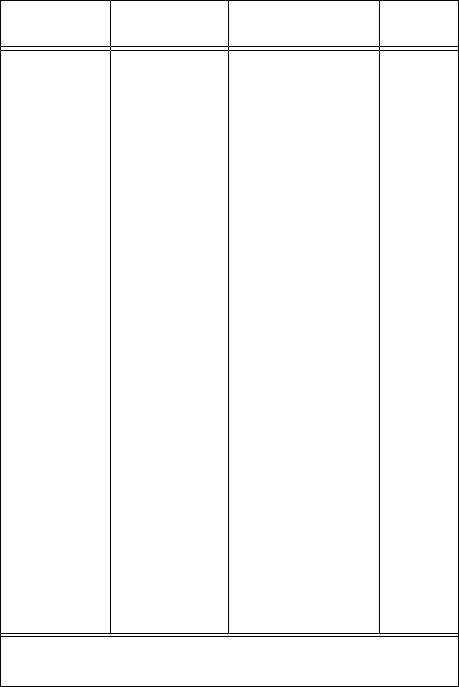
Table 292. VOLUME RESISTIVITY OF GLASS
(SHEET 2 OF 13)
|
|
|
Temperature |
Glass |
Description |
Resistivity |
(˚C) |
SiO2–Na2O glass |
(7.5% mol Na2O) |
7.59 log Ω cm |
150˚C |
|
(Con’t) |
||||
|
5.30 log Ω cm |
|
||
|
(7.5% mol Na2O) |
300˚C |
||
|
(7.8% mol Na2O) |
7.8x109 Ω cm |
100˚C |
|
|
(10% mol Na2O) |
7.35 log Ω cm |
150˚C |
|
|
(10% mol Na2O) |
6.14 log Ω cm |
250˚C |
|
|
(10% mol Na2O) |
5.18 log Ω cm |
300˚C |
|
|
(10% mol Na2O) |
4.96 log Ω cm |
350˚C |
|
|
(10% mol Na2O) |
1.03 log Ω cm |
1500˚C |
|
|
(10% mol Na2O) |
0.92 log Ω cm |
1600˚C |
|
|
(13% mol Na2O) |
6.90–6.96 log Ω cm |
150˚C |
|
|
(13% mol Na2O) |
4.77–4.79 log Ω cm |
300˚C |
|
|
(15% mol Na2O) |
5.44 log Ω cm |
250˚C |
|
|
(15% mol Na2O) |
4.32 log Ω cm |
350˚C |
|
|
(15% mol Na2O) |
0.61 log Ω cm |
1400˚C |
|
|
(15% mol Na2O) |
0.56 log Ω cm |
1500˚C |
|
|
(15.1% mol Na2O) |
1.4x108 Ω cm |
100˚C |
|
|
(19.9% mol Na2O) |
1.68 log Ω cm |
600˚C |
|
|
(19.9% mol Na2O) |
1.34 log Ω cm |
700˚C |
|
|
(19.9% mol Na2O) |
0.96 log Ω cm |
800˚C |
|
|
(19.9% mol Na2O) |
0.76 log Ω cm |
900˚C |
|
|
(19.9% mol Na2O) |
0.61 log Ω cm |
1000˚C |
|
|
(19.9% mol Na2O) |
0.48 log Ω cm |
1100˚C |
|
|
(19.9% mol Na2O) |
0.38 log Ω cm |
1200˚C |
|
|
(19.9% mol Na2O) |
0.30 log Ω cm |
1300˚C |
Source: data compiled by J. S. Park from O. V. Mazurin, M. V. Streltsina and T. P. ShvaikoShvaikovskaya, Handbook of Glass Data, Part A and Part B, Elsevier, New York, 1983
©2001 CRC Press LLC
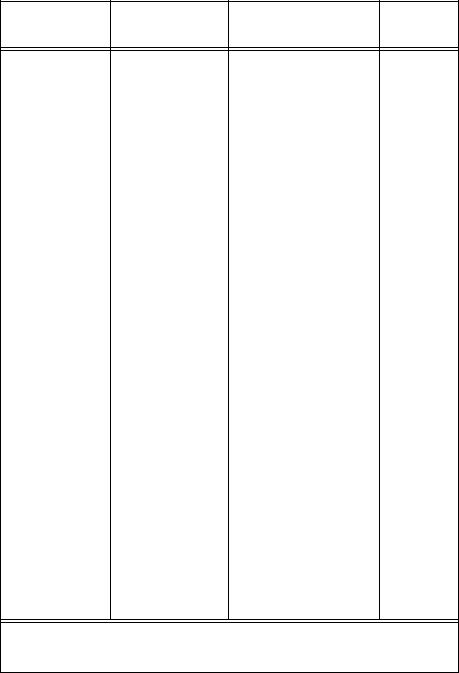
Table 292. VOLUME RESISTIVITY OF GLASS
(SHEET 3 OF 13)
|
|
|
Temperature |
Glass |
Description |
Resistivity |
(˚C) |
SiO2–Na2O glass |
(20% mol Na2O) |
6.45–6.80 log Ω cm |
150˚C |
|
(Con’t) |
||||
|
4.85 log Ω cm |
|
||
|
(20% mol Na2O) |
250˚C |
||
|
(20% mol Na2O) |
4.36–4.64 log Ω cm |
300˚C |
|
|
(20% mol Na2O) |
3.80 log Ω cm |
350˚C |
|
|
(24.8% mol Na2O) |
0.52 log Ω cm |
900˚C |
|
|
(24.8% mol Na2O) |
0.38 log Ω cm |
1000˚C |
|
|
(24.8% mol Na2O) |
0.26 log Ω cm |
1100˚C |
|
|
(24.8% mol Na2O) |
0.17 log Ω cm |
1200˚C |
|
|
(25% mol Na2O) |
6.05 log Ω cm |
150˚C |
|
|
(25% mol Na2O) |
4.50 log Ω cm |
250˚C |
|
|
(25% mol Na2O) |
4.03 log Ω cm |
300˚C |
|
|
(25% mol Na2O) |
3.52 log Ω cm |
350˚C |
|
|
(27% mol Na2O) |
5.87 log Ω cm |
150˚C |
|
|
(27% mol Na2O) |
3.94 log Ω cm |
300˚C |
|
|
(29.7% mol Na2O) |
1.31 log Ω cm |
550˚C |
|
|
(29.7% mol Na2O) |
1.16 log Ω cm |
600˚C |
|
|
(29.7% mol Na2O) |
0.78 log Ω cm |
700˚C |
|
|
(29.7% mol Na2O) |
0.52 log Ω cm |
800˚C |
|
|
(29.7% mol Na2O) |
0.34 log Ω cm |
900˚C |
|
|
(29.7% mol Na2O) |
0.20 log Ω cm |
1000˚C |
|
|
(29.7% mol Na2O) |
0.08 log Ω cm |
1100˚C |
|
|
(29.7% mol Na2O) |
–0.02 log Ω cm |
1200˚C |
|
|
(29.7% mol Na2O) |
–0.10 log Ω cm |
1300˚C |
|
|
(29.7% mol Na2O) |
–0.16 log Ω cm |
1400˚C |
Source: data compiled by J. S. Park from O. V. Mazurin, M. V. Streltsina and T. P. ShvaikoShvaikovskaya, Handbook of Glass Data, Part A and Part B, Elsevier, New York, 1983
©2001 CRC Press LLC

Table 292. VOLUME RESISTIVITY OF GLASS
(SHEET 4 OF 13)
|
|
|
Temperature |
Glass |
Description |
Resistivity |
(˚C) |
SiO2–Na2O glass |
(30% mol Na2O) |
5.48–5.75 log Ω cm |
150˚C |
|
(Con’t) |
||||
|
4.42 log Ω cm |
|
||
|
(30% mol Na2O) |
250˚C |
||
|
(30% mol Na2O) |
3.64–3.78 log Ω cm |
300˚C |
|
|
(30% mol Na2O) |
3.46 log Ω cm |
350˚C |
|
|
(30.2% mol Na2O) |
3.8x106 Ω cm |
100˚C |
|
|
(33.3% mol Na2O) |
5.06 log Ω cm |
150˚C |
|
|
(33.3% mol Na2O) |
3.34 log Ω cm |
300˚C |
|
|
(34.7% mol Na2O) |
0.12 log Ω cm |
900˚C |
|
|
(34.7% mol Na2O) |
0.00 log Ω cm |
1000˚C |
|
|
(34.7% mol Na2O) |
–0.11 log Ω cm |
1100˚C |
|
|
(34.7% mol Na2O) |
–0.20 log Ω cm |
1200˚C |
|
|
(34.7% mol Na2O) |
–0.27 log Ω cm |
1300˚C |
|
|
(34.7% mol Na2O) |
–0.33 log Ω cm |
1400˚C |
|
|
(35% mol Na2O) |
3.85 log Ω cm |
250˚C |
|
|
(35% mol Na2O) |
2.92 log Ω cm |
350˚C |
|
|
(36% mol Na2O) |
4.89 log Ω cm |
150˚C |
|
|
(36% mol Na2O) |
3.22 log Ω cm |
300˚C |
|
|
(39.5% mol Na2O) |
0.91 log Ω cm |
550˚C |
|
|
(39.5% mol Na2O) |
0.67 log Ω cm |
600˚C |
|
|
(39.5% mol Na2O) |
0.33 log Ω cm |
700˚C |
|
|
(39.5% mol Na2O) |
0.13 log Ω cm |
800˚C |
Source: data compiled by J. S. Park from O. V. Mazurin, M. V. Streltsina and T. P. ShvaikoShvaikovskaya, Handbook of Glass Data, Part A and Part B, Elsevier, New York, 1983
©2001 CRC Press LLC
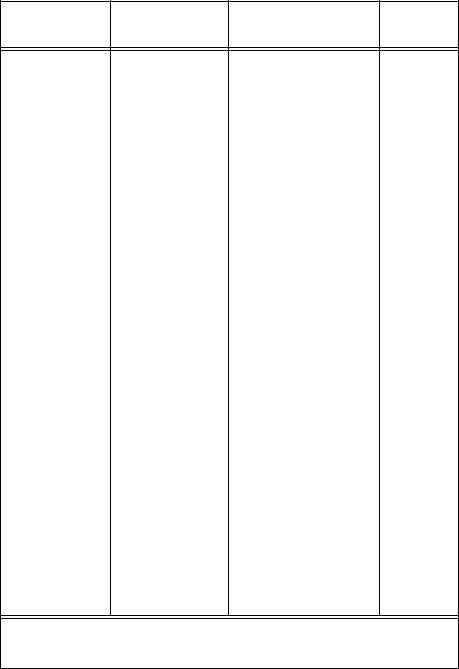
Table 292. VOLUME RESISTIVITY OF GLASS
(SHEET 5 OF 13)
|
|
|
Temperature |
Glass |
Description |
Resistivity |
(˚C) |
SiO2–Na2O glass |
(39.5% mol Na2O) |
0.00 log Ω cm |
900˚C |
|
(Con’t) |
||||
|
–0.13 log Ω cm |
|
||
|
(39.5% mol Na2O) |
1000˚C |
||
|
(39.5% mol Na2O) |
–0.24 log Ω cm |
1100˚C |
|
|
(39.5% mol Na2O) |
–0.32 log Ω cm |
1200˚C |
|
|
(39.5% mol Na2O) |
–0.39 log Ω cm |
1300˚C |
|
|
(39.5% mol Na2O) |
–0.45 log Ω cm |
1400˚C |
|
|
(40% mol Na2O) |
4.58 log Ω cm |
150˚C |
|
|
(40% mol Na2O) |
3.59 log Ω cm |
250˚C |
|
|
(40% mol Na2O) |
2.97 log Ω cm |
300˚C |
|
|
(40% mol Na2O) |
2.66 log Ω cm |
350˚C |
|
|
(44.2% mol Na2O) |
1.4x105 Ω cm |
100˚C |
|
|
(44.5% mol Na2O) |
–0.38 log Ω cm |
1100˚C |
|
|
(44.5% mol Na2O) |
–0.46 log Ω cm |
1200˚C |
|
|
(44.5% mol Na2O) |
–0.52 log Ω cm |
1300˚C |
|
|
(45% mol Na2O) |
4.33 log Ω cm |
150˚C |
|
|
(45% mol Na2O) |
3.30 log Ω cm |
250˚C |
|
|
(45% mol Na2O) |
2.69 log Ω cm |
300˚C |
|
|
(45% mol Na2O) |
2.35 log Ω cm |
350˚C |
|
|
(48% mol Na2O) |
4.09 log Ω cm |
150˚C |
|
|
(48% mol Na2O) |
2.58 log Ω cm |
300˚C |
|
|
(49.3% mol Na2O) |
–0.47 log Ω cm |
1100˚C |
|
|
(49.3% mol Na2O) |
–0.56 log Ω cm |
1200˚C |
|
|
(49.3% mol Na2O) |
–0.61 log Ω cm |
1300˚C |
Source: data compiled by J. S. Park from O. V. Mazurin, M. V. Streltsina and T. P. ShvaikoShvaikovskaya, Handbook of Glass Data, Part A and Part B, Elsevier, New York, 1983
©2001 CRC Press LLC
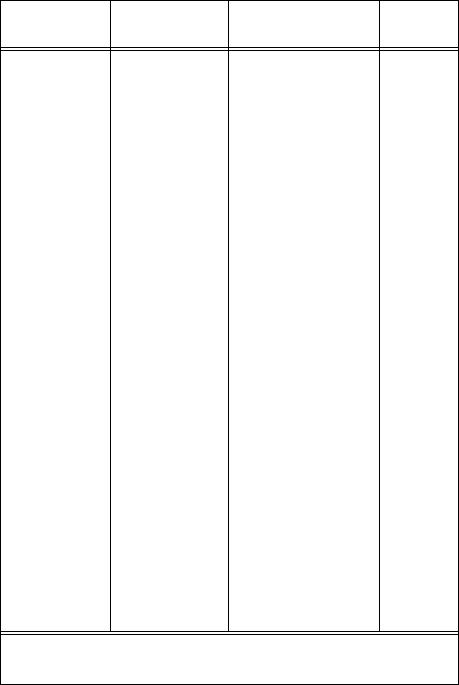
Table 292. VOLUME RESISTIVITY OF GLASS
(SHEET 6 OF 13)
|
|
|
Temperature |
Glass |
Description |
Resistivity |
(˚C) |
SiO2–Na2O glass |
(57.5% mol Na2O) |
–0.52 log Ω cm |
1100˚C |
|
(Con’t) |
||||
|
–0.61 log Ω cm |
|
||
|
(57.5% mol Na2O) |
1200˚C |
||
|
(57.5% mol Na2O) |
–0.67 log Ω cm |
1300˚C |
|
SiO2–PbO glass |
(30% mol PbO) |
12.94 log Ω cm |
200˚C |
|
|
(30% mol PbO) |
10.44 log Ω cm |
300˚C |
|
|
(33.8% mol PbO) |
16.14 log Ω cm |
66˚C |
|
|
(33.8% mol PbO) |
13.68 log Ω cm |
135˚C |
|
|
(35% mol PbO) |
12.10 log Ω cm |
200˚C |
|
|
(35% mol PbO) |
9.89 log Ω cm |
300˚C |
|
|
(38.5% mol PbO) |
4.40 log Ω cm |
700˚C |
|
|
(38.5% mol PbO) |
3.20 log Ω cm |
800˚C |
|
|
(38.5% mol PbO) |
2.47 log Ω cm |
900˚C |
|
|
(38.5% mol PbO) |
1.94 log Ω cm |
1000˚C |
|
|
(38.5% mol PbO) |
1.56 log Ω cm |
1100˚C |
|
|
(38.5% mol PbO) |
1.26 log Ω cm |
1200˚C |
|
|
(38.5% mol PbO) |
1.04 log Ω cm |
1300˚C |
|
|
(40% mol PbO) |
11.54 log Ω cm |
200˚C |
|
|
(40% mol PbO) |
9.48 log Ω cm |
300˚C |
|
|
(40.2% mol PbO) |
14.85 log Ω cm |
78˚C |
|
|
(40.2% mol PbO) |
11.70 log Ω cm |
175˚C |
|
|
(44.7% mol PbO) |
2.38 log Ω cm |
800˚C |
|
|
(44.7% mol PbO) |
1.82 log Ω cm |
900˚C |
|
|
(44.7% mol PbO) |
1.40 log Ω cm |
1000˚C |
|
|
(44.7% mol PbO) |
1.15 log Ω cm |
1100˚C |
|
|
(44.7% mol PbO) |
0.98 log Ω cm |
1200˚C |
|
|
(44.7% mol PbO) |
0.82 log Ω cm |
1300˚C |
Source: data compiled by J. S. Park from O. V. Mazurin, M. V. Streltsina and T. P. ShvaikoShvaikovskaya, Handbook of Glass Data, Part A and Part B, Elsevier, New York, 1983
©2001 CRC Press LLC

Table 292. VOLUME RESISTIVITY OF GLASS
(SHEET 7 OF 13)
|
|
|
Temperature |
Glass |
Description |
Resistivity |
(˚C) |
|
|
|
|
|
|
|
|
SiO2–PbO glass |
(47.3% mol PbO) |
14.48 log Ω cm |
79˚C |
(Con’t) |
|
11.74 log Ω cm |
|
|
(47.3% mol PbO) |
149˚C |
|
|
(50% mol PbO) |
10.69 log Ω cm |
200˚C |
|
(50% mol PbO) |
8.80–9.2 log Ω cm |
300˚C |
|
(50.0% mol PbO) |
1.90 log Ω cm |
800˚C |
|
(50.0% mol PbO) |
1.36 log Ω cm |
900˚C |
|
(50.0% mol PbO) |
1.02 log Ω cm |
1000˚C |
|
(50.0% mol PbO) |
0.80 log Ω cm |
1100˚C |
|
(50.0% mol PbO) |
0.60 log Ω cm |
1200˚C |
|
(51.4% mol PbO) |
14.52 log Ω cm |
65˚C |
|
(51.4% mol PbO) |
11.59 log Ω cm |
139˚C |
|
(51.6% mol PbO) |
1.62 log Ω cm |
800˚C |
|
(51.6% mol PbO) |
1.20 log Ω cm |
900˚C |
|
(51.6% mol PbO) |
0.92 log Ω cm |
1000˚C |
|
(51.6% mol PbO) |
0.70 log Ω cm |
1100˚C |
|
(51.6% mol PbO) |
0.54 log Ω cm |
1200˚C |
|
(57.1% mol PbO) |
13.70 log Ω cm |
77˚C |
|
(57.1% mol PbO) |
10.14 log Ω cm |
172˚C |
|
(60% mol PbO) |
10.04 log Ω cm |
200˚C |
|
(60% mol PbO) |
8.11 log Ω cm |
300˚C |
|
(60% mol PbO) |
1.72 log Ω cm |
650˚C |
|
(60% mol PbO) |
1.74 log Ω cm |
700˚C |
|
(60% mol PbO) |
1.07 log Ω cm |
800˚C |
|
(60% mol PbO) |
0.76 log Ω cm |
900˚C |
|
(60% mol PbO) |
0.40 log Ω cm |
1000˚C |
|
|
|
|
Source: data compiled by J. S. Park from O. V. Mazurin, M. V. Streltsina and T. P. ShvaikoShvaikovskaya, Handbook of Glass Data, Part A and Part B, Elsevier, New York, 1983
©2001 CRC Press LLC

Table 292. VOLUME RESISTIVITY OF GLASS
(SHEET 8 OF 13)
|
|
|
Temperature |
Glass |
Description |
Resistivity |
(˚C) |
|
|
|
|
|
|
|
|
SiO2–PbO glass |
(63.2% mol PbO) |
14.29 log Ω cm |
57˚C |
(Con’t) |
|
10.34 log Ω cm |
|
|
(63.2% mol PbO) |
159˚C |
|
|
(65% mol PbO) |
9.76 log Ω cm |
200˚C |
|
(65% mol PbO) |
7.81 log Ω cm |
300˚C |
|
(66.7% mol PbO) |
1.32 log Ω cm |
700˚C |
|
(66.7% mol PbO) |
0.82 log Ω cm |
800˚C |
|
(66.7% mol PbO) |
0.50 log Ω cm |
900˚C |
|
(66.7% mol PbO) |
0.26 log Ω cm |
1000˚C |
SiO2–CaO glass |
(33.6% mol CaO) |
0.97 log Ω cm |
1500˚C |
|
(33.6% mol CaO) |
0.93–0.94 log Ω cm |
1560˚C |
|
(33.6% mol CaO) |
0.79–0.80 log Ω cm |
1600˚C |
|
(41.3% mol CaO) |
0.82 log Ω cm |
1519˚C |
|
(41.3% mol CaO) |
0.76 log Ω cm |
1550˚C |
|
(41.3% mol CaO) |
0.67–0.68 log Ω cm |
1600˚C |
|
(45.4% mol CaO) |
0.65 log Ω cm |
1550˚C |
|
(45.4% mol CaO) |
0.58–0.59 log Ω cm |
1585˚C |
|
(45.4% mol CaO) |
0.52 log Ω cm |
1622˚C |
|
(50% mol CaO) |
12.2 log Ω cm |
300˚C |
|
(50% mol CaO) |
8.70 log Ω cm |
400˚C |
|
(51.4% mol CaO) |
0.48–0.49 log Ω cm |
1500˚C |
|
(51.4% mol CaO) |
0.47 log Ω cm |
1560˚C |
|
(51.4% mol CaO) |
0.38 log Ω cm |
1618˚C |
|
(55.2% mol CaO) |
0.51–0.53 log Ω cm |
1499˚C |
|
(55.2% mol CaO) |
0.42–0.43 log Ω cm |
1550˚C |
|
(55.2% mol CaO) |
0.34 log Ω cm |
1600˚C |
|
|
|
|
Source: data compiled by J. S. Park from O. V. Mazurin, M. V. Streltsina and T. P. ShvaikoShvaikovskaya, Handbook of Glass Data, Part A and Part B, Elsevier, New York, 1983
©2001 CRC Press LLC

Table 292. VOLUME RESISTIVITY OF GLASS
(SHEET 9 OF 13)
|
|
|
Temperature |
Glass |
Description |
Resistivity |
(˚C) |
|
|
|
|
|
|
|
|
SiO2–B2O3 glass |
(2.74% wt B2O3) |
5.30 log Ω cm |
900˚C |
|
(2.74% wt B2O3) |
4.72 log Ω cm |
1100˚C |
|
(2.74% wt B2O3) |
4.40 log Ω cm |
1300˚C |
|
(2.74% wt B2O3) |
4.02 log Ω cm |
1500˚C |
|
(2.74% wt B2O3) |
3.76 log Ω cm |
1700˚C |
|
(2.74% wt B2O3) |
3.56 log Ω cm |
1900˚C |
|
(5.48% wt B2O3) |
5.64 log Ω cm |
900˚C |
|
(5.48% wt B2O3) |
5.16 log Ω cm |
1100˚C |
|
(5.48% wt B2O3) |
4.56 log Ω cm |
1300˚C |
|
(5.48% wt B2O3) |
4.30 log Ω cm |
1500˚C |
|
(5.48% wt B2O3) |
4.10 log Ω cm |
1700˚C |
|
(5.48% wt B2O3) |
3.94 log Ω cm |
1900˚C |
|
(10.75% wt B2O3) |
5.74 log Ω cm |
900˚C |
|
(10.75% wt B2O3) |
5.08 log Ω cm |
1100˚C |
|
(10.75% wt B2O3) |
4.69 log Ω cm |
1300˚C |
|
(10.75% wt B2O3) |
4.40 log Ω cm |
1500˚C |
|
(10.75% wt B2O3) |
4.16 log Ω cm |
1700˚C |
|
(10.75% wt B2O3) |
3.98 log Ω cm |
1900˚C |
|
(19.37% wt B2O3) |
5.65 log Ω cm |
900˚C |
|
(19.37% wt B2O3) |
4.82 log Ω cm |
1100˚C |
|
(19.37% wt B2O3) |
4.48 log Ω cm |
1300˚C |
|
(19.37% wt B2O3) |
4.22 log Ω cm |
1500˚C |
|
(19.37% wt B2O3) |
4.00 log Ω cm |
1700˚C |
|
(19.37% wt B2O3) |
3.84 log Ω cm |
1900˚C |
|
|
|
|
Source: data compiled by J. S. Park from O. V. Mazurin, M. V. Streltsina and T. P. ShvaikoShvaikovskaya, Handbook of Glass Data, Part A and Part B, Elsevier, New York, 1983
©2001 CRC Press LLC

Table 292. VOLUME RESISTIVITY OF GLASS
(SHEET 10 OF 13)
|
|
|
Temperature |
Glass |
Description |
Resistivity |
(˚C) |
|
|
|
|
|
|
|
|
SiO2–Al2O3 glass |
(2.83% wt Al2O3) |
5.74 log Ω cm |
700˚C |
|
(2.83% wt Al2O3) |
4.82 log Ω cm |
900˚C |
|
(2.83% wt Al2O3) |
4.29 log Ω cm |
1100˚C |
|
(2.83% wt Al2O3) |
3.94 log Ω cm |
1300˚C |
|
(2.83% wt Al2O3) |
3.67 log Ω cm |
1500˚C |
|
(2.83% wt Al2O3) |
3.46 log Ω cm |
1700˚C |
|
(2.83% wt Al2O3) |
3.28 log Ω cm |
1900˚C |
|
(5.51% wt Al2O3) |
5.34 log Ω cm |
700˚C |
|
(5.51% wt Al2O3) |
4.65 log Ω cm |
900˚C |
|
(5.51% wt Al2O3) |
4.15 log Ω cm |
1100˚C |
|
(5.51% wt Al2O3) |
3.76 log Ω cm |
1300˚C |
|
(5.51% wt Al2O3) |
3.56 log Ω cm |
1500˚C |
|
(5.51% wt Al2O3) |
3.36 log Ω cm |
1700˚C |
|
(5.51% wt Al2O3) |
3.20 log Ω cm |
1900˚C |
|
(10.86% wt Al2O3) |
5.38 log Ω cm |
700˚C |
|
(10.86% wt Al2O3) |
4.54 log Ω cm |
900˚C |
|
(10.86% wt Al2O3) |
4.02 log Ω cm |
1100˚C |
|
(10.86% wt Al2O3) |
3.74 log Ω cm |
1300˚C |
|
(10.86% wt Al2O3) |
3.52 log Ω cm |
1500˚C |
|
(10.86% wt Al2O3) |
3.34 log Ω cm |
1700˚C |
|
(10.86% wt Al2O3) |
3.20 log Ω cm |
1900˚C |
B2O3 glass |
|
7.6 log Ω cm |
560˚C |
|
|
7.3 log Ω cm |
600˚C |
|
|
6.9 log Ω cm |
640˚C |
|
|
|
|
Source: data compiled by J. S. Park from O. V. Mazurin, M. V. Streltsina and T. P. ShvaikoShvaikovskaya, Handbook of Glass Data, Part A and Part B, Elsevier, New York, 1983
©2001 CRC Press LLC

Table 292. VOLUME RESISTIVITY OF GLASS
(SHEET 11 OF 13)
|
|
|
Temperature |
Glass |
Description |
Resistivity |
(˚C) |
|
|
|
|
|
|
|
|
B2O3 glass |
|
6.6 log Ω cm |
680˚C |
(Con’t) |
|
6.2 log Ω cm |
|
|
|
730˚C |
|
|
|
5.8 log Ω cm |
780˚C |
|
|
5.5 log Ω cm |
840˚C |
B2O3–Na2O glass |
(3.63% mol Na2O) |
2.70 log Ω cm |
800˚C |
|
(3.63% mol Na2O) |
2.30 log Ω cm |
900˚C |
|
(3.63% mol Na2O) |
2.00 log Ω cm |
1000˚C |
|
(10% mol Na2O) |
14.20 log Ω cm |
40˚C |
|
(10% mol Na2O) |
13.21 log Ω cm |
60˚C |
|
(10% mol Na2O) |
12.40 log Ω cm |
80˚C |
|
(10% mol Na2O) |
11.61 log Ω cm |
100˚C |
|
(12.1% mol Na2O) |
2.43 log Ω cm |
700˚C |
|
(12.1% mol Na2O) |
1.89 log Ω cm |
800˚C |
|
(12.1% mol Na2O) |
1.48 log Ω cm |
900˚C |
|
(16% mol Na2O) |
15.89 log Ω cm |
40˚C |
|
(16% mol Na2O) |
15.08 log Ω cm |
60˚C |
|
(16% mol Na2O) |
14.32 log Ω cm |
80˚C |
|
(16% mol Na2O) |
13.58 log Ω cm |
100˚C |
|
(17.3% mol Na2O) |
1.39 log Ω cm |
850˚C |
|
(17.3% mol Na2O) |
1.18 log Ω cm |
900˚C |
|
(17.3% mol Na2O) |
0.89 log Ω cm |
1000˚C |
|
(20% mol Na2O) |
13.86 log Ω cm |
40˚C |
|
(20% mol Na2O) |
12.91 log Ω cm |
60˚C |
|
(20% mol Na2O) |
12.05 log Ω cm |
80˚C |
|
(20% mol Na2O) |
11.28 log Ω cm |
100˚C |
|
|
|
|
Source: data compiled by J. S. Park from O. V. Mazurin, M. V. Streltsina and T. P. ShvaikoShvaikovskaya, Handbook of Glass Data, Part A and Part B, Elsevier, New York, 1983
©2001 CRC Press LLC

Table 292. VOLUME RESISTIVITY OF GLASS
(SHEET 12 OF 13)
|
|
|
Temperature |
Glass |
Description |
Resistivity |
(˚C) |
B2O3–Na2O glass |
(21.9% mol Na2O) |
1.29 log Ω cm |
800˚C |
|
(Con’t) |
||||
|
0.94 log Ω cm |
|
||
|
(21.9% mol Na2O) |
900˚C |
||
|
(21.9% mol Na2O) |
0.65 log Ω cm |
1000˚C |
|
|
(27.5% mol Na2O) |
1.00 log Ω cm |
800˚C |
|
|
(27.5% mol Na2O) |
0.70 log Ω cm |
900˚C |
|
|
(30% mol Na2O) |
11.90 log Ω cm |
40˚C |
|
|
(30% mol Na2O) |
10.14 log Ω cm |
60˚C |
|
|
(30% mol Na2O) |
9.43 log Ω cm |
80˚C |
|
|
(30% mol Na2O) |
8.82 log Ω cm |
100˚C |
|
|
(32.8% mol Na2O) |
1.02 log Ω cm |
700˚C |
|
|
(32.8% mol Na2O) |
0.60 log Ω cm |
800˚C |
|
|
(32.8% mol Na2O) |
0.40 log Ω cm |
900˚C |
|
|
(40% mol Na2O) |
10.48 log Ω cm |
40˚C |
|
|
(40% mol Na2O) |
9.73 log Ω cm |
60˚C |
|
|
(40% mol Na2O) |
9.08 log Ω cm |
80˚C |
|
|
(40% mol Na2O) |
8.46 log Ω cm |
100˚C |
|
B2O3–CaO glass |
(33.3% mol CaO) |
14.40 log Ω cm |
150˚C |
|
|
(33.3% mol CaO) |
13.92 log Ω cm |
200˚C |
|
|
(33.3% mol CaO) |
13.50 log Ω cm |
250˚C |
|
|
(33.3% mol CaO) |
13.16 log Ω cm |
300˚C |
|
|
(33.3% mol CaO) |
3.10 log Ω cm |
850˚C |
|
|
(33.3% mol CaO) |
2.25 log Ω cm |
950˚C |
|
|
(33.3% mol CaO) |
1.52 log Ω cm |
1050˚C |
|
|
(33.3% mol CaO) |
1.10 log Ω cm |
1150˚C |
|
|
(33.3% mol CaO) |
0.85 log Ω cm |
1250˚C |
Source: data compiled by J. S. Park from O. V. Mazurin, M. V. Streltsina and T. P. ShvaikoShvaikovskaya, Handbook of Glass Data, Part A and Part B, Elsevier, New York, 1983
©2001 CRC Press LLC

Table 292. VOLUME RESISTIVITY OF GLASS
(SHEET 13 OF 13)
|
|
|
Temperature |
Glass |
Description |
Resistivity |
(˚C) |
|
|
|
|
|
|
|
|
B2O3–CaO glass |
(40.0% mol CaO) |
2.97 log Ω cm |
850˚C |
(Con’t) |
|
2.06 log Ω cm |
|
|
(40.0% mol CaO) |
950˚C |
|
|
(40.0% mol CaO) |
1.40 log Ω cm |
1050˚C |
|
(40.0% mol CaO) |
0.98 log Ω cm |
1150˚C |
|
(40.0% mol CaO) |
0.75 log Ω cm |
1250˚C |
|
(55.4% mol CaO) |
6.13 log Ω cm |
750˚C |
|
(55.4% mol CaO) |
3.86 log Ω cm |
850˚C |
|
(55.4% mol CaO) |
2.46 log Ω cm |
950˚C |
|
(55.4% mol CaO) |
1.70 log Ω cm |
1050˚C |
|
(55.4% mol CaO) |
1.22 log Ω cm |
1150˚C |
|
|
|
|
Source: data compiled by J. S. Park from O. V. Mazurin, M. V. Streltsina and T. P. ShvaikoShvaikovskaya, Handbook of Glass Data, Part A and Part B, Elsevier, New York, 1983
©2001 CRC Press LLC

Table 293. VOLUME RESISTIVITY OF POLYMERS
(SHEET 1 OF 8)
|
|
Volume Resistivity, |
|
|
|
(ASTM D257) |
|
Polymer |
Type |
(Ω • cm) |
|
|
|
|
|
|
|
|
|
ABS Resins; Molded, |
Medium impact |
2—4 x 1015 |
|
Extruded |
|||
|
|
||
|
High impact |
1—4 x 1015 |
|
|
Very high impact |
1—4 x 1015 |
|
|
Low temperature impact |
1—4 x 1015 |
|
|
Heat resistant |
1—5 x 1015 |
|
Acrylics; Cast, Molded, |
Cast Resin Sheets, Rods: |
|
|
Extruded |
|
||
|
|
||
|
General purpose, type I |
>1015 |
|
|
General purpose, type II |
>1015 |
|
|
Moldings: |
|
|
|
Grades 5, 6, 8 |
>1014 |
|
|
High impact grade |
2.0 x 1016 |
|
Thermoset Carbonate |
Allyl diglycol carbonate |
4 x 1014 |
|
Alkyds; Molded |
Putty (encapsulating) |
1014 |
|
|
Rope (general purpose) |
1014 |
|
|
Granular (high speed molding) |
1014 — 1015 |
|
|
Glass reinforced (heavy duty parts) |
1014 |
|
Cellulose Acetate; |
ASTM Grade: |
|
|
Molded, Extruded |
|
||
|
|
||
|
H6—1 |
1010—1013 |
|
|
H4—1 |
1010—1013 |
|
|
H2—1 |
1010—1013 |
|
|
|
|
Source: data compiled by J.S. Park from Charles T. Lynch, CRC Handbook of Materials Science, Vol. 3, CRC Press, Boca Raton, Florida, 1975 and Engineered Materials Handbook, Vol.2, Engineering Plastics, ASM International, Metals Park, Ohio, 1988.
©2001 CRC Press LLC

Table 293. VOLUME RESISTIVITY OF POLYMERS
(SHEET 2 OF 8)
|
|
Volume Resistivity, |
|
|
|
(ASTM D257) |
|
Polymer |
Type |
(Ω • cm) |
|
|
|
|
|
|
|
|
|
Cellulose Acetate; |
|
1010—1013 |
|
Molded, Extruded |
MH—1, MH—2 |
||
(Con’t) |
|
|
|
|
MS—1, MS—2 |
1010—1013 |
|
|
S2—1 |
1010—1013 |
|
Cellulose Acetate |
|
|
|
Butyrate; Molded, |
ASTM Grade: |
|
|
Extruded |
|
|
|
|
H4 |
1011—1014 |
|
|
MH |
1011—1014 |
|
|
S2 |
1011—1014 |
|
Cellusose Acetate |
|
|
|
Propionate; Molded, |
ASTM Grade: |
|
|
Extruded |
|
|
|
|
1 |
1011—1014 |
|
|
3 |
1011—1014 |
|
|
6 |
1011—1014 |
|
Chlorinated Polymers |
Chlorinated polyether |
1.5 x 1016 |
|
|
Chlorinated polyvinyl chloride |
1 x 1015—2 x 1016 |
|
Polycarbonates |
Polycarbonate |
2.1 x 1016 |
|
|
Polycarbonate (40% glass fiber |
1.4 x 1015 |
|
|
reinforced) |
||
|
|
||
Diallyl Phthalates; |
Orlon filled |
6 x 104—6 x 106 |
|
Molded |
|||
|
|
||
|
Dacron filled |
102—2.5 x 104 |
|
|
Asbestos filled |
102—5 x 103 |
|
|
Glass fiber filled |
104—5 x 104 |
|
|
|
|
Source: data compiled by J.S. Park from Charles T. Lynch, CRC Handbook of Materials Science, Vol. 3, CRC Press, Boca Raton, Florida, 1975 and Engineered Materials Handbook, Vol.2, Engineering Plastics, ASM International, Metals Park, Ohio, 1988.
©2001 CRC Press LLC

Table 293. VOLUME RESISTIVITY OF POLYMERS
(SHEET 3 OF 8)
|
|
Volume Resistivity, |
|
|
|
(ASTM D257) |
|
Polymer |
Type |
(Ω • cm) |
|
|
|
|
|
|
|
|
|
Fluorocarbons; |
Polytetrifluoro chloroethylene |
1018 |
|
Molded,Extruded |
(PTFCE) |
||
|
|||
|
Polytetrafluoroethylene (PTFE) |
>1018 |
|
|
Ceramic reinforced (PTFE) |
1015 |
|
|
Fluorinated ethylene |
>2 x 1018 |
|
|
propylene(FEP) |
||
|
|
||
|
Polyvinylidene— fluoride (PVDF) |
5 x 1014 |
|
Epoxies; Cast, Molded, |
Standard epoxies (diglycidyl ethers |
|
|
Reinforced |
of bisphenol A) |
|
|
|
Cast rigid |
6.1 x 1015 |
|
|
Cast flexible |
9.1 x 105—6.7 x 109 |
|
|
Molded |
1—5 x 1015 |
|
|
High strength laminate |
6.6 x 107—109 |
|
Epoxies—Molded, |
High performance resins |
|
|
Extruded |
(cycloaliphatic diepoxides) |
|
|
|
Cast, rigid |
2.10 x 1014 |
|
|
Molded |
1.4—5.5 x 1014 |
|
Epoxy novolacs |
Cast, rigid |
>1016 |
|
Melamines; Molded |
Filler & type |
|
|
|
Cellulose electrical |
1012—1013 |
|
|
Glass fiber |
1—7 x 1011 |
|
|
Alpha cellulose and mineral |
1012 |
|
|
|
|
Source: data compiled by J.S. Park from Charles T. Lynch, CRC Handbook of Materials Science, Vol. 3, CRC Press, Boca Raton, Florida, 1975 and Engineered Materials Handbook, Vol.2, Engineering Plastics, ASM International, Metals Park, Ohio, 1988.
©2001 CRC Press LLC

Table 293. VOLUME RESISTIVITY OF POLYMERS
(SHEET 4 OF 8)
|
|
Volume Resistivity, |
|
|
(ASTM D257) |
Polymer |
Type |
(Ω • cm) |
|
|
|
|
|
|
Nylons; Molded, |
Type 6 |
|
Extruded |
|
|
|
|
|
|
General purpose |
4.5 x 1013 |
|
Glass fiber (30%) reinforced |
2.8 x 1014—1.5 x 1015 |
|
Cast |
2.6 x 1014 |
|
Type 8 |
1.5 x 1011 |
|
Type 11 |
2 x 1013 |
|
Type 12 |
1014 —1015 |
|
6/6 Nylon |
|
|
General purpose molding |
1014—1015 |
|
Glass fiber reinforced |
2.6—5.5 x 1015 |
|
General purpose extrusion |
1015 |
|
6/10 Nylon |
|
|
General purpose |
1015 |
Phenolics; Molded |
Type and filler |
|
|
General: woodflour and flock |
109—1013 |
|
Shock: paper, flock, or pulp |
1—50 x 1011 |
|
High shock: chopped fabric or cord |
>1010 |
|
Very high shock: glass fiber |
1010 — 1011 |
|
Arc resistant—mineral |
1010 — 1012 |
|
Rubber phenolic—woodflour or |
108—1011 |
|
flock |
|
|
|
|
|
Rubber phenolic—chopped fabric |
1011 |
|
Rubber phenolic—asbestos |
1011 |
|
|
|
Source: data compiled by J.S. Park from Charles T. Lynch, CRC Handbook of Materials Science, Vol. 3, CRC Press, Boca Raton, Florida, 1975 and Engineered Materials Handbook, Vol.2, Engineering Plastics, ASM International, Metals Park, Ohio, 1988.
©2001 CRC Press LLC

Table 293. VOLUME RESISTIVITY OF POLYMERS
(SHEET 5 OF 8)
|
|
Volume Resistivity, |
|
|
|
(ASTM D257) |
|
Polymer |
Type |
(Ω • cm) |
|
|
|
|
|
|
|
|
|
Phenolics; Molded |
ABS—Polycarbonate Alloy |
2.2 x 1016 |
|
(Con’t) |
|||
|
|
||
|
PVC—Acrylic Alloy |
|
|
|
PVC—acrylic Sheet |
l—5 x 1013 |
|
|
PVC—acrylic injection molded |
5 x l015 |
|
Polymides |
Unreinforced |
4 x 1015 |
|
|
Glass reinforced |
9.2 x 1015 |
|
Polyacetals |
Homopolymer: |
|
|
|
Standard |
1 x 1015 |
|
|
20% glass reinforced |
5 x 1014 |
|
|
Copolymer: |
|
|
|
Standard |
1 x 1014 |
|
|
25% glass reinforced |
1.2 x 1014 |
|
|
High flow |
1.0 x 1014 |
|
Polyester; |
Injection Moldings: |
|
|
Thermoplastic |
|
||
|
|
||
|
General purpose grade |
1—4 x 1016 |
|
|
Glass reinforced grades |
3.2—3.3 x 1016 |
|
|
Glass reinforced self extinguishing |
3.4 x 1016 |
|
|
General purpose grade |
2 x 1015 |
|
|
Asbestos—filled grade |
3 x 1014 |
|
Polyesters: Thermosets |
Cast polyyester |
|
|
|
Rigid |
1013 |
|
|
Flexible |
1012 |
|
|
|
|
Source: data compiled by J.S. Park from Charles T. Lynch, CRC Handbook of Materials Science, Vol. 3, CRC Press, Boca Raton, Florida, 1975 and Engineered Materials Handbook, Vol.2, Engineering Plastics, ASM International, Metals Park, Ohio, 1988.
©2001 CRC Press LLC

Table 293. VOLUME RESISTIVITY OF POLYMERS
(SHEET 6 OF 8)
|
|
Volume Resistivity, |
|
|
|
(ASTM D257) |
|
Polymer |
Type |
(Ω • cm) |
|
|
|
|
|
|
|
|
|
Polyesters: Thermosets |
Reinforced polyester moldings |
|
|
(Con’t) |
|
||
|
|
||
|
High strength (glass fibers) |
1 x 1012 —1 x 1013 |
|
|
Heat and chemical resistant |
1 x 1012 —1 x 1013 |
|
|
(asbestos) |
||
|
|
||
|
Sheet molding compounds, general |
6.4 x 1015 —2.2 x 1016 |
|
|
purpose |
||
|
|
||
|
Phenylene Oxides |
|
|
|
SE—100 |
1017 |
|
|
SE—1 |
1017 |
|
|
Glass fiber reinforced |
1017 |
|
Phenylene oxides |
Standard |
5 x 1016 |
|
(Noryl) |
|||
|
|
||
|
Glass fiber reinforced |
1017 |
|
|
Polyarylsulfone |
3.2—7.71 x l016 |
|
Polypropylene |
General purpose |
>1017 |
|
|
High impact |
1017 |
|
|
Asbestos filled |
1.5 x 1015 |
|
|
Glass reinforced |
1.7 x 1016 |
|
|
Flame retardant |
4 x 1016—1017 |
|
Polyphenylene sulfide |
40% glass reinforced |
4.5 x 1014 |
|
|
|
|
Source: data compiled by J.S. Park from Charles T. Lynch, CRC Handbook of Materials Science, Vol. 3, CRC Press, Boca Raton, Florida, 1975 and Engineered Materials Handbook, Vol.2, Engineering Plastics, ASM International, Metals Park, Ohio, 1988.
©2001 CRC Press LLC

Table 293. VOLUME RESISTIVITY OF POLYMERS
(SHEET 7 OF 8)
|
|
Volume Resistivity, |
|
|
|
(ASTM D257) |
|
Polymer |
Type |
(Ω • cm) |
|
|
|
|
|
|
|
|
|
Polyethylenes; Molded, |
Type I—lower density |
|
|
Extruded |
(0.910—0.925) |
|
|
|
Melt index 0.3—3.6 |
1017—1019 |
|
|
Melt index 6—26 |
1017—1019 |
|
|
Melt index 200 |
1017—1019 |
|
|
Type II—medium density |
|
|
|
(0.926—0.940) |
|
|
|
Melt index 20 |
>1015 |
|
|
Melt index l.0—1.9 |
>1015 |
|
|
Type III—higher density |
|
|
|
(0.941—0.965) |
|
|
|
Melt index 0.2—0.9 |
>1015 |
|
|
Melt Melt index 0.l—12.0 |
>1015 |
|
|
Melt index 1.5—15 |
>1015 |
|
|
High molecular weight |
>1015 |
|
Olefin Copolymers; |
EEA (ethylene ethyl acrylate) |
2.4 x 1015 |
|
Molded |
|||
|
|
||
|
EVA (ethylene vinyl acetate) |
0.15 x 1015 |
|
|
Ionomer |
10 x 1015 |
|
|
Polyallomer |
>1016 |
|
Polystyrenes; Molded |
Polystyrenes |
|
|
|
General purpose |
>1016 |
|
|
Medium impact |
>1016 |
|
|
High impact |
>1016 |
|
|
|
|
Source: data compiled by J.S. Park from Charles T. Lynch, CRC Handbook of Materials Science, Vol. 3, CRC Press, Boca Raton, Florida, 1975 and Engineered Materials Handbook, Vol.2, Engineering Plastics, ASM International, Metals Park, Ohio, 1988.
©2001 CRC Press LLC

Table 293. VOLUME RESISTIVITY OF POLYMERS
(SHEET 8 OF 8)
|
|
Volume Resistivity, |
|
|
|
(ASTM D257) |
|
Polymer |
Type |
(Ω • cm) |
|
|
|
|
|
|
|
|
|
Polystyrenes; Molded |
Glass fiber -30% reinforced |
3.6 x 1016 |
|
(Con’t) |
|||
|
|
||
|
Styrene acrylonitrile (SAN) |
>1016 |
|
|
Glass fiber (30%) reinforced SAN |
4.4 x 1016 |
|
Polyvinyl Chloride And |
|
1—700 x 1012 |
|
Copolymers; Molded, |
Nonrigid—general |
||
Extruded |
|
|
|
|
Nonrigid—electrical |
4—300 x 1011 |
|
|
Rigid—normal impact |
1014—1016 |
|
|
Vinylidene chloride |
1014—1016 |
|
|
Silicones; Molded, Laminated |
(dry) |
|
|
Fibrous (glass) reinforced silicones |
9 x 1014 |
|
|
Granular (silica) reinforced |
5 x 1014 |
|
|
silicones |
||
|
|
||
|
Woven glass fabric/ silicone |
2—5 x 1014 |
|
|
laminate |
||
|
|
||
Ureas; Molded |
Alpha—cellulose filled |
0.5—5 x 1011 |
|
(ASTM Type l) |
|||
|
|
||
|
Cellulose filled (ASTM Type 2) |
5—8 x 1010 |
|
|
|
|
Source: data compiled by J.S. Park from Charles T. Lynch, CRC Handbook of Materials Science, Vol. 3, CRC Press, Boca Raton, Florida, 1975 and Engineered Materials Handbook, Vol.2, Engineering Plastics, ASM International, Metals Park, Ohio, 1988.
©2001 CRC Press LLC

Table 294. CRITICAL TEMPERATURE OF
SUPERCONDUCTIVE ELEMENTS (SHEET 1 OF 2)
Element |
Tc(K) |
|
|
|
|
Al |
1.175 |
Be |
0.026 |
Cd |
0.518-0.52 |
Ga |
1.0833 |
Ga (β) |
5.90-6.2 |
Ga (γ) |
7.62 |
Ga (δ) |
7.85 |
Hg (α) |
4.154 |
Hg (β) |
3.949 |
In |
3.405 |
Ir |
0.11-0.14 |
La (α) |
4.88 |
La (β) |
6.00 |
Mo |
0.916 |
Nb |
9.25 |
Os |
0.655 |
Pa |
1.4 |
Pb |
7.23 |
Re |
1.697 |
Ru |
0.493 |
Sb |
2.6-2.7a |
Sn |
3.721 |
Ta |
4.47 |
Tc |
7.73-7.78 |
Th |
1.39 |
|
|
a Metastable.
Source: data from Roberts, B. W., Properties of Selected Superconductive Materials - 1974 Supplement, NBS Technical Note 825, National Bureau of Standards, U.S. Government Printing Office, Washington,D.C., 1974, 10.
©2001 CRC Press LLC

Table 294. CRITICAL TEMPERATURE OF
SUPERCONDUCTIVE ELEMENTS (SHEET 2 OF 2)
Element |
Tc(K) |
|
|
|
|
Ti |
0.39 |
Ti |
2.332-2.39 |
V |
5.43-5.31 |
W |
0.0154 |
Zn |
0.875 |
Zr |
0.53 |
Zr (ω) |
0.65 |
|
|
a Metastable.
Source: data from Roberts, B. W., Properties of Selected Superconductive Materials - 1974 Supplement, NBS Technical Note 825, National Bureau of Standards, U.S. Government Printing Office, Washington,D.C., 1974, 10.
©2001 CRC Press LLC
